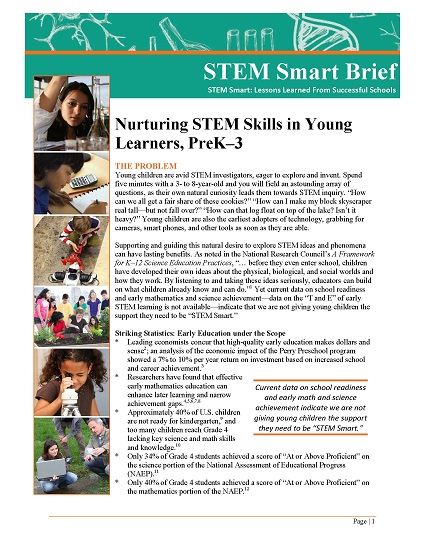New evidence continues to emerge on the formative potential of the early years in a person's life. NSF is investing in programs to transform STEM teaching and learning in preK and the early grades. This Spotlight features DRK–12-funded projects and other resources that seek to leverage early learning opportunities.
In this Spotlight:
See the 2020 Spotlight on Early Childhood Education.
Featured Projects

As part of this Spotlight on Early STEM Learning, 14 DRK–12 projects describe their work on early learning in science, mathematics, and computer science and share their challenges, findings, and products:
- Bilingualtek: An Integrated Science-Language Approach for Latinx Preschoolers (PI: Lucía Méndez)
- Building a Flexible and Comprehensive Approach to Supporting Student Development of Whole Number Understanding (PI: Benjamin Clarke)
- CAREER: Investigating Young Children's Opportunities to Learn Mathematics in Early Childhood Classrooms (PI: Nicholas Johnson)
- CAREER: Sparking "Number Talks" to Strengthen Mathematical Identities (PI: Dawn Woods)
- Developing and Validating Assessments to Measure and Build Elementary Teachers' Content Knowledge for Teaching about Matter and Its Interactions within Teacher Education Settings (Collaborative Research) (PIs: Deborah Hanuscin, Jamie Mikeska)
- Examining Potential Causal Connections and Mechanisms Between Children's Block Play and Mathematics Learning (PI: Sara Schmitt)
- Exploring Early Childhood Teachers’ Abilities to Identify Computational Thinking Precursors to Strengthen Computer Science in Classrooms (PI: Sean Justice)
- Investigating Early Elementary Students' Computational Thinking Development in Integrated Mathematics-Coding Instruction (PI: Jessica Shumway)
- Math Partners: Collaborations to Support Early Math Learning (PI: Stephanie Smith)
- Number and Spatial Skill Development from 2 Years to 2nd Grade: Examining Associations with Home Math Environments in Early and Middle Childhood (PI: Heather Bachman)
- Professional Learning Hub for Early Science (HubES): Leveraging Technology to Develop Supports for Educators to Promote Meaningful Science Learning in Preschool (PI: Ximena Dominguez)
- The Impact of an Inclusive Grades K–2 Early Algebra Intervention Implemented by Classroom Teachers (PI: Maria Blanton)
- The Smart Playground: Computational Thinking Through Robotics in Early Childhood (Collaborative Research) (PI: Marina Bers, Andres Bustamante, Chris Rogers)
- Young Mathematicians: Expanding an Innovative and Promising Model Across Learning Environments to Promote Preschoolers' Mathematics Knowledge (PI: Jessica Young)
Featured Projects

Bilingualtek: An Integrated Science-Language Approach for Latinx Preschoolers
PI: Lucía Méndez
Grades: PreK
STEM Disciplines: Science
Project Description: Early childhood education currently faces challenges related to effective science instruction practices that meet the learning needs of culturally and linguistically diverse children, such as multilingual and dual language learners (DLL), who enter the school system speaking a different language at home from the mainstream language of instruction. This project seeks to foster the science achievement of all preschoolers, including children who are DLL, through an integrated science-language instructional approach for preschool classrooms. The approach uses everyday science experiences to engage preschoolers who are DLLs in learning the practices of scientists, including observing, predicting and using language to communicate scientific findings. These aims are accomplished by combining engaging science experiences focus on exploring phenomena and inquiry-based preschool science instruction. We also use e books and multimedia supports to complement and support science and language learning. Consistent with the Next Generation of Science Standards (NGSS), the project offers a transformative model of early childhood science and language education that supports kindergarten readiness at a national level and addresses the vital need for educational resources that build on and enhance the strengths of children who are DLLs.
What theoretical framework(s) are you using to guide your work?
Bilingualtek, an integrated science-language instructional approach, focuses on engaging science experiences with culturally and linguistically responsive shared readings. This approach, which aims to support children’s science achievement while co-developing language skills, is based on a conceptual framework that views science and language learning as a synergistic process where the learning outcome of the combined instruction is greater than that of its individual domains (Lee, Llosa, Grapin, Haas, & Goggins, 2019; Peterson & French, 2008; Stoddart, Pinal, Latzke, and Canaday, 2002).
What models or techniques are you researching and developing that are specific to this age range?
The science-language instructional practices that we are developing bring together preschool teachers and families of children who are DLL in an iterative co-design process to develop instructional content, including co-designing engaging science experiences guided by the Cycle of Discovery, as well as culturally responsive science-based shared readings and media supports to facilitate science and language learning by all preschoolers including those who are DLL.
What knowledge, skills, or other outcomes is your project focused on supporting and/or measuring?
When this project was implemented in Head Start preschools, we examined Bilingualtek’s usability, feasibility, and preliminary efficacy, including child outcomes (science talk, science knowledge, and language skills) through a quasiexperimental field study.
What kinds of partners did you involve to support your work in PreK–3 learning environments?
The project was implemented in Head Start preschool classrooms with preschool teachers and preschool children who are DLL. Additionally, we co-designed Bilingualtek’s activities with input from preschool teachers and families of preschoolers who participated in our study.
What are the unique challenges related to your work in this age range and what strategies has your project identified for addressing them?
Some of the challenges include limited early science education instruction for teachers, minimal incorporation of NGSS science principles in early science learning for preschoolers, and increasing numbers of DLLs entering preschools experiencing a shortage of multilingual early childhood teachers. The project addresses these challenges by leveraging recent research with preschool DLLs across several disciplines into a media-supported integrated science-language instructional approach. These instructional practices provide an NGSS aligned model for preschool-age science education at the national level, support kindergarten readiness, and directly address the need for educational resources that build on the strengths that multilingual children bring to their learning experience. This approach can be embedded into preschools’ curricula, providing teachers a rich context for children’s engagement with scientific phenomena, inquiry-based preschool science instruction, and science-based shared readings via e-books.
Initial Project Findings: Initial findings demonstrate that early childhood teachers participating in a science-language instructional experience were generally positive and willing to take up opportunities to learn about a multimedia, synergistic science and language instructional approach. Although the notion that English should be the dominant language of instruction still prevails, several teachers reported feeling that it was important to provide science instruction to multilingual learners in both English and children’s home language. Teachers needed to first increase their understanding of the process of second language learning and how multilingualism supports learning, particularly in young DLLs. Over time, and with direct and explicit learning opportunities, teachers increased their understanding of the how language supports science learning and vice versa in young DLLs and how to integrate English and the home language, using technology in science instruction.
We also learned that there is a positive association between use of a science-language based instructional approach like Bilingualtek and children’s academic language gains post intervention in English and the children’s home language. These findings provide preliminary evidence supporting the usability, feasibility, and efficacy of the Bilingualtek approach.
Products
Publications:
- La Paro, K., Méndez, L. I., Stage, V. C., & Lee, T., (Submitted). Bilingualtek, a culturally-linguistically science-language instructional approach: Implementing engaging science activities with young Latine children. Journal of Early Childhood Teacher Education.
- Lee, T., Stage, V. C., Méndez, L. I., & La Paro, K. (Submitted). Exploring our world through investigating trash: Recycle and reuse. Young Children.
Presentations:
- Méndez, L. I., & La Paro, K., Lee, T., & Stage, V. C. Bilingualtek: Dual Language and Science Learning in the Classroom. Workshop presentation to be delivered (accepted) at the National Association for the Education of Young Children (NAEYC) Conference (Nov, 2025).
- Méndez, L. I., La Paro, K., Lee, T., & Stage, V. C. Bilingualtek: An Intervention to Support Children Gains in Science Language Learning. (April 2025). Poster presentation. Society for the Research of Child Development Convention (SRCD), Minneapolis, MN.
- Lee, T., Stage, V. C., Méndez, L., & Paro La, K. (2025). Engaging Young Children in Scientific and Engineering Practices. International Conference on Education. Bangkok, Thailand.
- Méndez, L. I., Kayumova, S., Quintos, B., Civil, M. (2023). Applying Translanguaging, Culture & Community-Sustaining Pedagogies and STEAM as Asset-Based Approaches to Broadening Participation in STEM. NSF DRK-PI Meeting, Arlington, VA.
- Méndez, L., La Paro, K., Lee, T., & Stage, V. (2023). Bilingualtek: An Integrated Language-Science Instructional Approach for Latino/a Dual Language Learners. NSF DRK-12 PI Meeting, Arlington, VA.
- Méndez, L., La Paro, K., Lee, T., & Stage, V. (2022). Science and Language Instruction Practices that Support Latino dual language learners in Head Start. National Research Conference in Early Childhood. Virtual.
Suggested Reading:
- Hernandez, C. & Shroyer, M.G. (2017). The use of culturally responsive teaching strategies among Latina/o student teaching interns during science and mathematics instruction of CLD students. Journal of Science Teacher Education, 28(4), 367–387.
- Lee, O., Llosa, L., Grapin, S. E., Haas, A., & Goggins, M. (2019). Science and language integration with English learners: A conceptual framework guiding instructional materials development. Science Education, 103(2), 317-337.
- Lee, O. & Stephens, A. (2020). English learners in STEM subjects: Contemporary views on STEM subjects and language with English learners. Educational Researcher, 49(6). https://doi.org/10.3102/0013189X20923708
- Méndez, L. I., Lee, T., Hegde, A. V., McMillan, V., Goodell, L. S., Bayles, J., & Stage, V. (2023). Let’s talk: Linking science and language learning in the preschool classroom. Young Children, 78(2), 66-76.
- Méndez, L. I., Hammer, C., Lopez, L., & Blair, C. (2018). Examining language and early numeracy skills in young Latino dual language learners. Early Childhood Research Quarterly. https://doi.org/10.1016/j.ecresq.2018.02.004
- National Academies of Sciences, Engineering, & Medicine. (2018). English learners in STEM subjects: Transforming classrooms, schools, and lives. National Academies Press.
- National Academies of Sciences, Engineering, & Medicine. (2021). Science and engineering in preschool through elementary grades: The brilliance of children and the strengths of educators. National Academies Press.
- Stoddart, T., Pinal, A., Latzke, M., & Canaday, D. (2002). Integrating inquiry science and language development for English language learners. Journal of Research in Science Teaching, 39(8), 664–687. https://doi.org/10.1002/tea.10040.
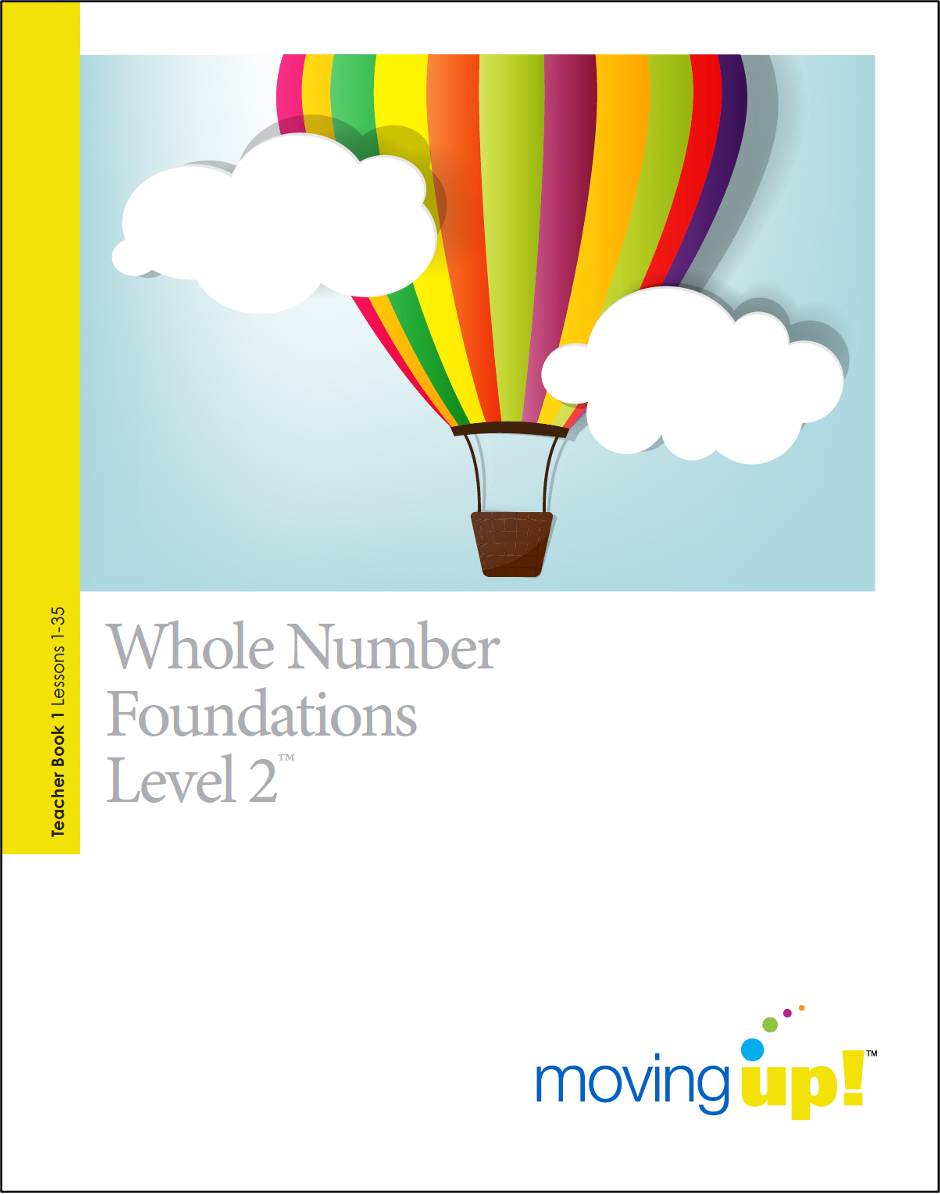
Building a Flexible and Comprehensive Approach to Supporting Student Development of Whole Number Understanding
PI: Benjamin Clarke
Grades: K–2
STEM Disciplines: Mathematics
Project Description: Project FLEX is developing a second-grade mathematics intervention focused on building students’ understanding of whole number concepts and skills. This new program, Whole Number Foundations–Second Grade (WNF-2), is designed to address a critical gap in early math intervention by providing targeted, research-based instruction to second grade students with or at risk for mathematics learning disabilities (MLD).
WNF-2 builds on two previously validated interventions for kindergarten and first grade and will ultimately complete a vertically aligned K–2 instructional system: the Whole Number Foundations–Intervention System (WNF-IS). Together, these programs offer coherent, multi-year support to help students develop conceptual understanding, procedural fluency, and mathematical reasoning with whole numbers.
Project FLEX emphasizes instructional intensity within second grade while also enabling flexible use of earlier-grade content to address unfinished learning. By embedding the intervention within school-based multi-tiered systems of support (MTSS), the project seeks to expand equitable access to high-quality mathematics instruction, particularly for students from groups historically underrepresented in STEM fields.
What theoretical framework(s) are you using to guide your work?
Project FLEX is grounded in a design science approach (Clements, 2007; Doabler et al., 2015), which guides iterative development through cycles of observation, analysis, and refinement. The intervention content is informed by developmental learning trajectories (Clements & Sarama, 2004; Confrey, 2012) and draws from research on effective instructional practices for students with or at risk for MLD. Our design also incorporates the Common Core State Standards–Mathematics (CCSS-M); the Standards for Mathematical Practice; and strengths-based teaching approaches that emphasize student agency, problem-solving, and conceptual understanding (Fuchs, 2021).
What models or techniques are you researching and developing that are specific to this age range?
We are developing a second-grade mathematics intervention (WNF-2) that targets critical whole number concepts through explicit, conceptually grounded instruction. Lessons integrate concrete-representational-abstract (CRA) models and structured math discourse. Lessons focus on building both conceptual understanding and procedural fluency. Key mathematical content areas include (a) number combinations, (b) place value, (c) multi-digit addition and subtraction, (d) word problem solving, and (e) foundations for multiplication. A schematic-broadening approach supports transfer of word problem-solving skills.
What kinds of partners did you involve to support your work in PreK–3 learning environments?
We partnered with two Oregon public school districts to co-develop, test, and refine the WNF-2 intervention. Within those districts, we enlisted teachers and paraprofessionals to teach intervention lessons to gain usable insights and feedback from our intended end-users. These districts serve diverse student populations, including many multilingual learners. Teachers, interventionists, and school leaders provided critical input through feasibility studies, surveys, focus groups, and pilot testing. Their collaboration ensured the program was both instructionally sound and logistically feasible in real-world school settings.
What are the unique challenges related to your work in this age range and what strategies has your project identified for addressing them?
Second grade represents a critical but under-supported phase in early math development. Despite strong intervention infrastructure at K–1, few validated programs exist for second grade. Compounding this, students with persistent MLD often require sustained, multi-year support. Our strategy is to build a flexible, coherent K–2 intervention system that allows educators to deliver content across grade levels based on students’ learning trajectories. WNF-2 also addresses the need for increased conceptual depth and problem-solving skills, not just procedural accuracy.
What is something you think is important for the broader community (other STEM education researchers, policymakers, industry representatives, and/or the public) to know about early STEM learning?
Early math intervention plays a vital role in long-term success in STEM, particularly for students at risk of falling behind. Many current systems provide only a single year of support and tend to emphasize procedural fluency at the expense of conceptual understanding. Project FLEX highlights the importance of sustained, developmentally appropriate instruction in foundational concepts such as whole numbers. By focusing on deep mathematical understanding and problem-solving in the early grades, we can significantly improve outcomes for students and reduce persistent opportunity gaps. Helping students become confident mathematical thinkers by second grade is not only achievable but also critical for equitable access to future STEM opportunities.
Initial Project Findings: In the FLEX pilot study, 129 students were randomly assigned to participate in the FLEX intervention or a business-as-usual control group.
Students who received FLEX achieved greater gains compared to control students on a proximal assessment (g = 0.42), math curriculum-based measures (ASPENS; g = 0.56 and easyCBM; g = 0.28), and on a brief mathematics vocabulary assessment (g = 1.23).
Direct observations revealed that implementation fidelity was adequate to strong.
Classroom teachers agreed or strongly agreed that the intervention content was important for second grade students, was feasible for instructional assistants to implement, and that the intervention improved their students’ math performance.
Products:
- Lesner, T., Sutherland, M., Clarke, B., Kosty, D., Turtura, J., & Doabler, C. (2025). Exploring Initial Outcomes of a Supplemental Second Grade Math Intervention. Paper presented at the National Association of School Psychologists Annual Convention, Seattle, WA.
- Lesner, T., Nelson, G., Sutherland, M., & Clarke, B. (2024, June 26-28). Developing a Second Grade Mathematics Intervention with Attention to Mathematics Vocabulary. Symposium presented at the Mathematical Cognition and Learning Society conference, Washington, D.C.
- Sutherland, M., Lesner, T., Nelson, G., Turtura, J., Doabler, C. T., & Clarke, B. (2023). The Iterative Design and Development of a Second Grade Mathematics Intervention Program. Poster presented at the 31st Annual Pacific Coast Research Conference, Coronado, CA.
Suggested Reading:
- Clarke, B., Doabler, C. T., Sutherland, M., Kosty, D., Turtura, J., & Smolkowski, K. (2022). Examining the impact of a first grade whole number intervention by group size. Journal of Research on Educational Effectiveness, 16(2), 326-349. https://doi.org/10.1080/19345747.2022.209329
- Clarke, B., Doabler, C. T., Turtura, J., Smolkowski, K., Kosty, D. B., Sutherland, M., Kurtz-Nelson, E., Fien, H., & Baker, S. K. (2020). Examining the efficacy of a kindergarten mathematics intervention by group size and initial skill: Implications for practice and policy. The Elementary School Journal, 121(1), 125-153. https://doi.org/10.1086/710041
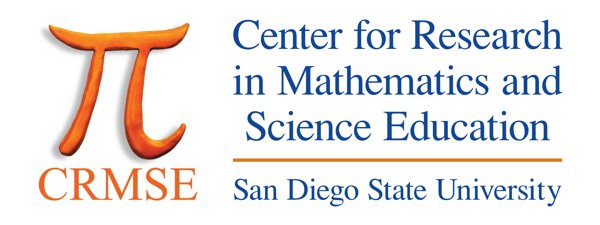 CAREER: Investigating Young Children's Opportunities to Learn Mathematics in Early Childhood Classrooms
CAREER: Investigating Young Children's Opportunities to Learn Mathematics in Early Childhood Classrooms
PI: Nicholas Johnson
Grades: PreK, TK, K
STEM Disciplines: Mathematics
Project Description: Children's early math experiences are critically important. The mathematics they learn builds a powerful foundation for elementary school and beyond. Just as important are the relationships they begin to develop with mathematics: Is mathematics a place where children’s ideas matter? Does it make sense? Is it a space for joy and collaboration with peers? Our project traces children's early math experiences over time during early childhood to better understand various approaches to early math learning and teaching.
What theoretical framework(s) are you using to guide your work?
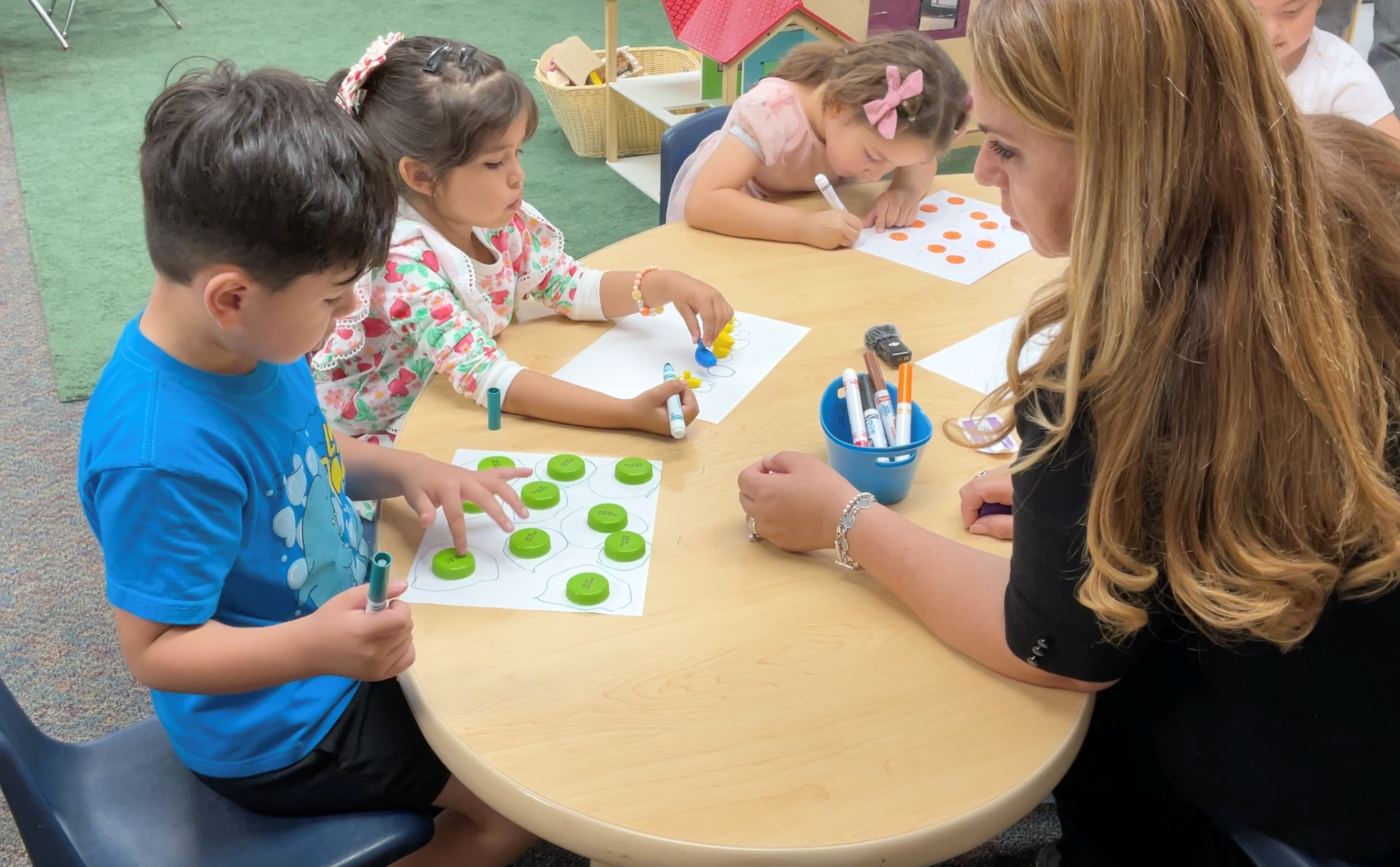 Our project foregrounds people’s evolving participation in socially and culturally organized activity (Lave, 2019; Nasir et al., 2020). This perspective focuses our attention on the situated nature of interactions between people, tasks, tools, and symbols that mediate doing mathematics. We also attend to the embodied, material nature of young children’s mathematical work (Radford, 2014) as they communicate their understandings through movement, gesture, facial expressions, and sounds of excitement or confusion.
Our project foregrounds people’s evolving participation in socially and culturally organized activity (Lave, 2019; Nasir et al., 2020). This perspective focuses our attention on the situated nature of interactions between people, tasks, tools, and symbols that mediate doing mathematics. We also attend to the embodied, material nature of young children’s mathematical work (Radford, 2014) as they communicate their understandings through movement, gesture, facial expressions, and sounds of excitement or confusion.
What are the unique challenges related to your work in this age range and what strategies has your project identified for addressing them?
In addition to verbal communication, much of how young children communicate mathematically involves how they use of objects, gestures, and facial expressions. For this reason, we spend lots of time in early childhood classrooms observing and collecting photographs and videos of children’s mathematical work. We have also designed novel measures (e.g., a non-standard shape puzzle) to capture the development of spatial relations and early number.
Products:
- Johnson, N. C. & de Alba, C. A. (accepted). Development and early use of a novel spatial relations task in early childhood. To appear in Proceedings of the forty-seventh annual meeting of the North American Chapter of the International Group for the Psychology of Mathematics Education. State College, Pennsylvania.
- de Alba, C. A. & Johnson, N. C. (accepted). Exploring the affordances of assessing counting with challenging tasks. To appear in Proceedings of the forty-seventh annual meeting of the North American Chapter of the International Group for the Psychology of Mathematics Education. State College, Pennsylvania.
- Johnson, N. C. & de Alba, C. A. (submitted). “¿De qué otra forma lo podemos hacer?” The elevation of cognitive demand in preschool. [Paper session]. American Educational Research Association Annual Meeting, Los Angeles, CA.
Suggested Reading:
- Celedón-Pattichis, S. & Turner, E. E. (2012). “Explícame tu Respuesta”: Supporting the development of mathematical discourse in emergent bilingual kindergarten students. Bilingual Research Journal, 35(2), 197–216. https://doi.org/10.1080/15235882.2012.703635
- Development and Research in Early Math Education (2025). DREME | TE: Early Math Resources for Teacher Educators. https://prek-math-te.stanford.edu/
- Parks, A. N. (2020). Centering children in mathematics education classroom research. American Educational Research Journal, 57(4), 1443–1484. https://doi.org/10.3102/0002831219873853
- Shalaby, C. (2017). Troublemakers: Lessons in freedom from young children at school. The New Press.
- Stipek, D., Franke, M., Clements, D., Farran, D., & Coburn, C. (2017). PK-3: What does it mean for instruction? Social Policy Report, 30(2), 1–23. https://doi.org/10.1002/j.2379-3988.2017.tb00087.x
- Turrou, A. C., Johnson, N. C., & Franke, M. L. (2021). The young child and mathematics (3rd ed). National Association for the Education of Young Children.
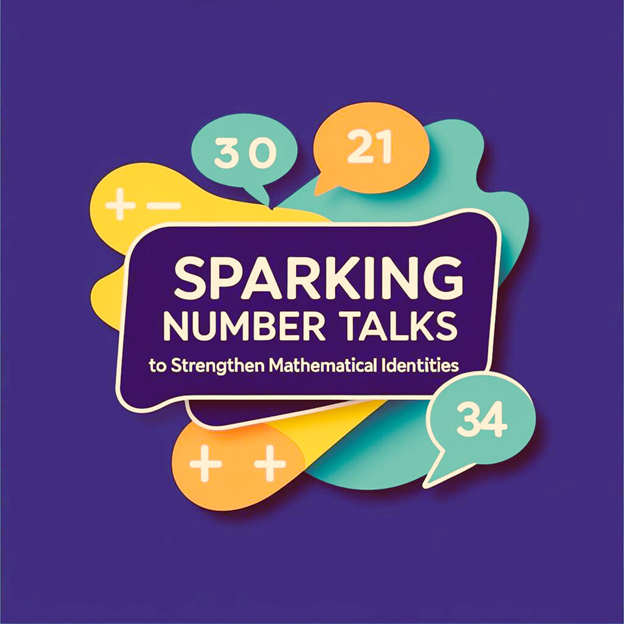 CAREER: Sparking "Number Talks" to Strengthen Mathematical Identities
CAREER: Sparking "Number Talks" to Strengthen Mathematical Identities
PI: Dawn Woods
Grades: TK–3
STEM Disciplines: Mathematics
Project Description: This five-year participatory research project follows 100+ students from kindergarten to third grade to understand whether and how Number Talks (i.e., ten-to-fifteen-minute math discussions where students mentally solve mathematics problems and then come together as a class to share their mathematical reasoning) can empower students to develop productive mathematical identities while strengthening their number sense. A productive mathematical identity is characterized by seeing sense in mathematics, perceiving it as useful, and believing that steady effort in learning mathematics pays off. When number sense is used to cultivate productive mathematical identities, students understand, relate, and connect numbers with a deeper understanding of how numbers work together. Hence, students identify as someone who can do mathematics.
There are three aims of this project. Aim 1 identifies and documents the strengths (e.g., knowledge, skills, and resources that individuals create through their interactions with others and their environment) each student brings with them to mathematics class. Aim 2 supports teachers to leverage these strengths to intentionally design, enact, and revise Number Talks supporting both number sense and identity development. Aim 3 identifies the design principles of number talks that positively impact productive mathematical identity development while determining how mathematical identity evolves over time. In sum, this project seeks to improve transitional kindergarten to grade 3 mathematics by cultivating sensemaking opportunities via Number Talks designed to deepen mathematical understanding so that students experience the wonder and joy of mathematics, while identifying as confident and capable learners.
What theoretical framework(s) are you using to guide your work?
The situated perspective of identity is a framework that guides my work. It conceptualizes and operationalizes mathematical identity as a joint accomplishment (Hand & Gresalfi, 2015). This means that one’s participation in and across Number Talks and the sense one makes of oneself in relation to Number Talks is a combined effort between what an individual does in the activity and in connection to what one has opportunities to do (Greeno & MMAP, 1998). Further, I posit that an individual’s funds of knowledge (FoK) (i.e., the knowledge, resources, and strengths families and communities possess; González et al., 2005) and funds of identity (FoI) (i.e., the bodies of knowledge, skills, and resources that individuals create through their interactions with others and their environment; Esteban-Guitart, 2016; Esteban-Guitart & Moll, 2014) provide pathways for individuals to extend learning in personal and culturally relevant directions (Alverz et al., 2021). This means that both FoK and FoI are strengths and resources supporting self-expression, self-definition, and self-understanding and should be leveraged as resources for Number Talk design and enactment with students.
What models or techniques are you researching and developing that are specific to this age range?
As part of this project, I am developing a model to understand young children’s self-portraits. In the context of this project, self-portraits are child-created drawings in response to the prompt, “draw yourself doing math”. These drawings contain visible and invisible identity markers representing the child’s identity, beliefs, values, or interests related to themselves and mathematics.
What kinds of partners did you involve to support your work in PreK–3 learning environments?
Partners for this project include three elementary schools with a large, public, suburban district in the Midwest. Each year of the project, grade level teams of teachers are invited to participate in the participatory research project that follows the same core group of students (with parental permission) from TK to grade 3.
What are the unique challenges related to your work in this age range and what strategies has your project identified for addressing them?
A unique challenge related to this work is developing a model to understand young children’s mathematical identities. Since little work has explored young children’s mathematical identity development or representations of their identities, I am using an arts-based approach which centers self-portraits as a methodology to capture visible and invisible identity markers. These markers represent the young child’s identity, beliefs, values, or interests related to themselves and mathematics.
What is something you think is important for the broader community (other STEM education researchers, policymakers, industry representatives, and/or the public) to know about early STEM learning?
Early STEM learning is essential because it fosters critical thinking, problem solving, and creativity while allowing students to experience the wonder and joy of STEM disciplines. These opportunities promote a love of learning and instill confidence, which supports students to identify as self-assured and capable learners.
Products
Conference Proceedings/Presentations:
- Woods, D. & Xu, F. (2025). Leveraging young children’s funds of knowledge to spark number talks. The Psychology of Mathematics Education in North America 47, State College, PA.
- Xu, F. & Woods, D. (2025). Changing mathematics: How one teacher grew elicitation practices through number talks. The Psychology of Mathematics Education in North America 47, State College, PA.
- Woods, D. & Xu, F. (under review). “Who am I?”: How do young children represent their (mathematical) identities? Paper submitted to the American Educational Research Association, Los Angeles, CA.
Practitioner Article:
- Woods, D. & Neal, A. (in preparation). “Where do you see math?”: Nurturing student agency during number talks. Paper will be submitted to Mathematics Teacher: Learning and Teaching PK-12.
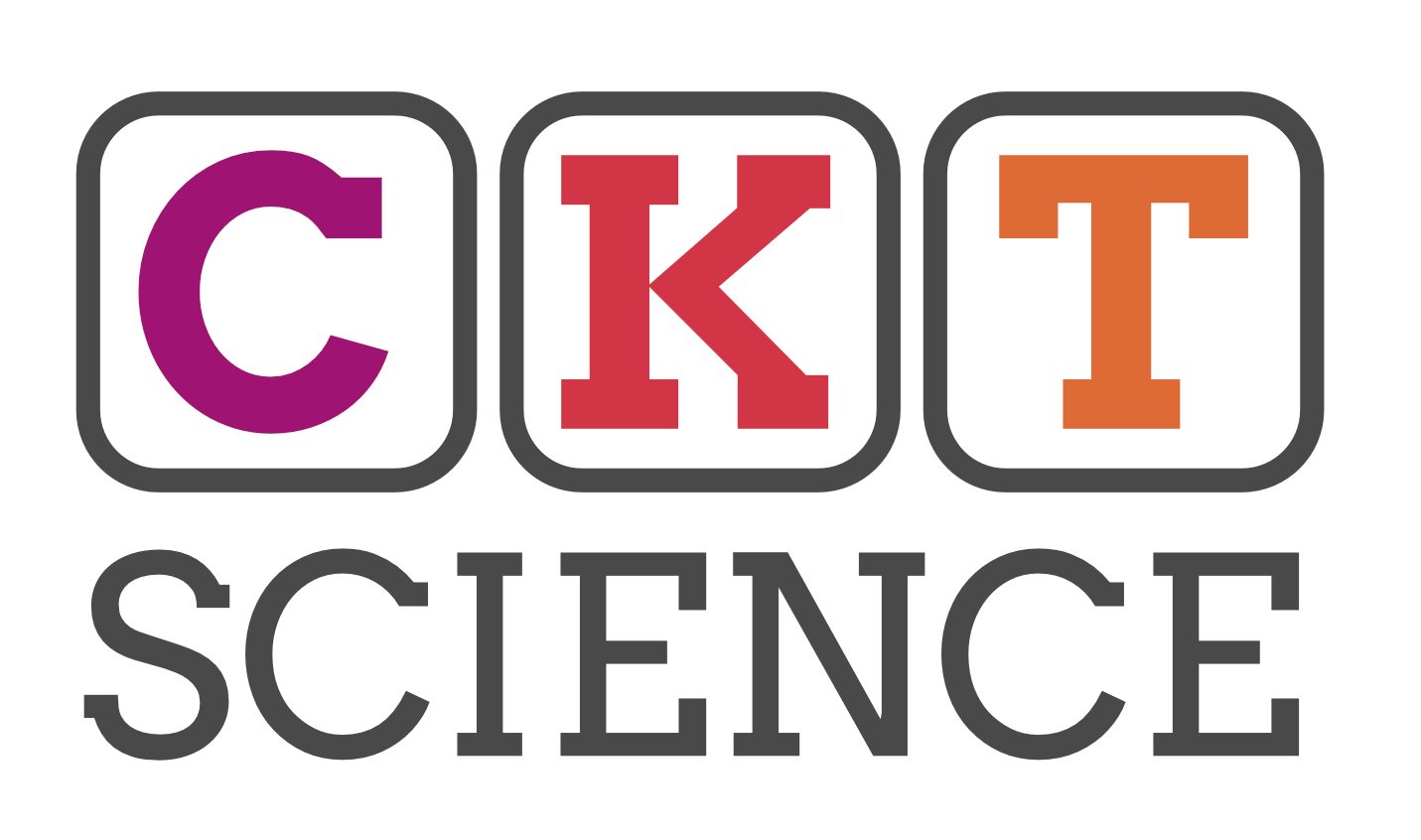 Developing and Validating Assessments to Measure and Build Elementary Teachers' Content Knowledge for Teaching about Matter and Its Interactions within Teacher Education Settings (Collaborative Research)
Developing and Validating Assessments to Measure and Build Elementary Teachers' Content Knowledge for Teaching about Matter and Its Interactions within Teacher Education Settings (Collaborative Research)
PIs: Deborah Hanuscin, Jamie Mikeska
Grades: K–6
STEM Disciplines: Science
Project Description: Building a well-prepared elementary science teacher workforce is critical to ensuring that students are provided with the learning experiences they need to address the performance expectations in the Next Generation Science Standards. To do so, the field needs valid assessment tools to monitor and improve elementary science teachers’ learning. In this project, researchers at ETS and Western Washington University collaborated with elementary science teachers, teacher educators, and assessment developers to develop and validate: (a) a summative assessment instrument to measure elementary preservice teachers’ (PSTs’) content knowledge for teaching (CKT) in one important content topic: matter and its interactions and (b) a set of instructional materials that can be used by elementary teacher educators within science content and methods courses to develop elementary PSTs’ CKT about matter and its interactions. We conducted foundational research to understand how elementary science teacher educators used the instructional materials as part of their course curriculum to build elementary PSTs’ CKT about matter and its interactions and to understand the nature and dimensionality of PSTs’ CKT about matter and its interactions.
What theoretical framework(s) are you using to guide your work?
CKT refers to the usable knowledge that teachers draw upon as they engage in the work of teaching and includes both teachers’ subject matter knowledge and their pedagogical content knowledge. For example, when teaching about matter and its interactions, elementary science teachers need to draw upon their understanding of key concepts related to this topic, such as their knowledge about ways to describe and classify matter and why matter is conserved in various situations. They also need to use their knowledge about different activities and investigations that are useful to help students develop their own understanding about properties of matter and about different previous experiences and conceptions students bring with them to their learning in this topic area.
We designed and used CKT matter assessment items as part of the summative assessment instrument and as part of each CKT matter instructional packet. Each CKT matter assessment item lives at the intersection of the science content—in this case, one of five different matter topics (e.g., properties of matter, conservation of matter) and one of seven work of teaching science instructional tools categories (e.g., scientific resources, scientific models). For example, one CKT matter item might assess PSTs’ ability to evaluate instructional resources that assess student understanding about what matter is while another CKT item might assess PSTs’ ability to help students in developing scientific arguments using evidence from investigations to establish that matter cannot be created or destroyed.
Initial Project Findings: Our team conducted several pilot studies and one large field test using the CKT matter items for the summative assessment. In the pilot studies, we conducted interviews with elementary PSTs as they responded to a subset of the CKT matter items and shared their thought processes about their answer selection and any challenges they encountered. Pilot findings showed that most CKT matter items were measuring the CKT that we intended, and the PSTs thought that the CKT matter items were connected to their own or other teachers’ science teaching experiences. Most PSTs also reported that they believed it was important for elementary teachers to know how to answer these items. The pilot also revealed which items to retain, further refine, or drop. In the field test, we administered a 60-item CKT matter assessment online to 822 elementary PSTs. In the first part of our analysis, we conducted a classical item analysis of the field test data to identify well-functioning items, flag and remove (as needed) poor functioning items, and build the final assessment form of 52 CKT matter items. In the second part of our analysis, we fit a one-dimension model and several multidimensional item response theory (MIRT) models to examine the nature of elementary PSTs’ CKT about matter. Overall, we did not find much evidence supporting distinct knowledge dimensions by the matter content categories or the work of teaching science instructional tool categories, which points to the overall integrated nature of CKT about matter. These results suggest the viability for developing and using automatically scorable CKT science assessments to provide useful information about science PSTs’ CKT, which opens the door for using such assessments to monitor the impact of or make decisions about the focus of teachers’ professional development or designing similar CKT assessments in other areas. Our team used these results to create an automatically generated score report that can provide the CKT matter assessment results for individual PSTs or across a class of PSTs.
Our project also developed and investigated the use of instructional materials that elementary teacher educators and professional developers can use and adapt in their work facilitating professional learning with elementary PSTs to develop their CKT about matter and its interactions. Case studies have shown the viability of using these materials in both content and pedagogy courses, and our initial findings from quantitative analysis showed that the number of packets implemented related to gains in PSTs’ CKT as measured by the CKT matter summative assessment.
Products: Our team’s publicly available project website, which is located at https://sites.google.com/wwu.edu/cktscience/home, provides information about the project goals, project staff, and research presentations and publications. Our website provides access to the CKT matter assessment that individuals can take on their own or a teacher educator can assign to their pre-service teachers. It also provides access to the CKT matter instructional packets.
Suggested Reading:
- The National Academies report Science and Engineering in Preschool Through Elementary Grades: The Brilliance of Children and the Strengths of Educators emphasizes that, starting in early childhood, children are capable of learning sophisticated science and engineering concepts. Teachers need well-developed CKT to help students develop their understanding of these concepts.
- The SciEPlay SEP Toolbox & Video Library is a set of resources that were designed with and for early childhood educators to identify and support play-based science and engineering practices. The collaborative research team plans to publish the professional learning materials and videos on their project website in 2026. These resources were developed as part of a NSF-funded collaborative research project titled “Bridging Preschool and Kindergarten Science: Exploring Play-based Engagement with Scientific and Engineering Practices in Early Learning Environments.” For those who want to learn more about this work, they can watch the project’s introduction video and join their mailing list to be notified when the materials are "live.”
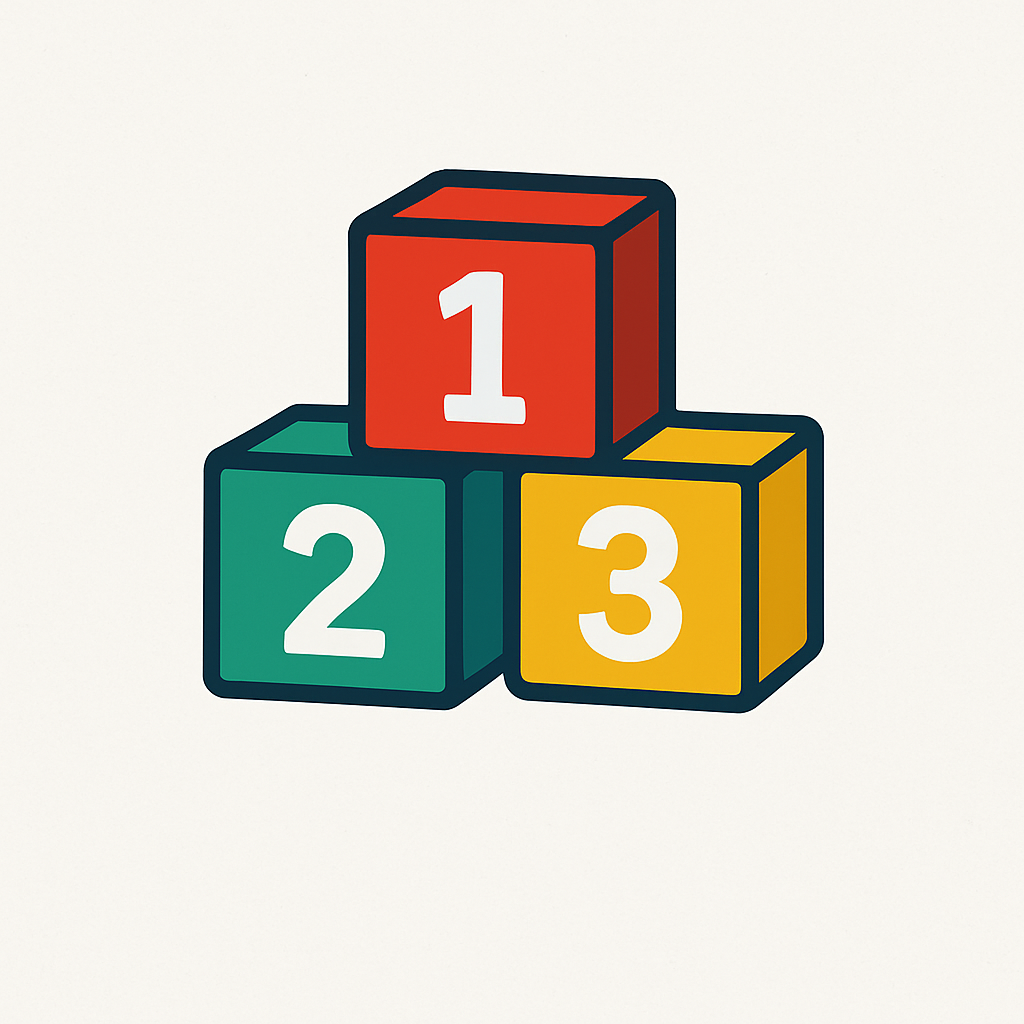 Examining Potential Causal Connections and Mechanisms Between Children's Block Play and Mathematics Learning
Examining Potential Causal Connections and Mechanisms Between Children's Block Play and Mathematics Learning
PI: Sara Schmitt
Grades: Preschool
STEM Disciplines: Mathematics
Project Description: To ensure maximal impact on children’s outcomes, STEM experiences need to be based on sound empirical evidence. Preschool teachers need validated methods for providing high quality STEM experiences, such as block activities, in ways that are conducive to children’s learning, are low cost, and can fit into existing classroom routines (e.g., small group time). In this study, our primary goal is to further develop, refine, and evaluate a research-based STEM learning tool (i.e., block play) that tests theories of mathematical learning. Block play is ubiquitous in preschool settings and is an important context where the development of math skills, a critical component of STEM learning, and STEM-related skills, including spatial reasoning and executive function, can occur. Despite how common block play is in preschool classrooms, few studies have examined whether and why block play may support early math, spatial reasoning, or executive function. In this randomized controlled trial, we are addressing this gap in the literature by testing the extent to which different types of block play (i.e., free play with blocks, semi-structured play with blocks) promote our target outcomes and exploring whether executive function mediates associations between block play and math outcomes. Through this work, we will establish an empirically supported understanding of how different types of block play affect the acquisition of early math skills and identify why block play influences the development of these skills. Our findings will contribute to the current theoretical understanding regarding how block play serves as a STEM experience, which will have implications for STEM learning and teaching.
Initial Project Findings: Preregistered analyses indicate that three intervention effects were statistically significant, two favoring the free play with blocks group over the business-as-usual (BAU) control group: geometry skills (b=0.37, p=.010) and global executive function (b=0.23, p=.017), and one favoring the BAU group over the free play with blocks group: math language (b=-0.18, p=.034). Despite only finding three significant effects, the overall pattern of results suggests positive effects of both block play interventions (i.e., effect sizes were positive for 10 of the 12 outcomes). Further, results from preliminary mediation analyses suggest that free play with blocks is indirectly related to numeracy, cardinality, and numeral identification working through a global assessment of executive function.
Products:
- Geer, E. A., Devlin, B. L., Zehner, T., Korucu, I., Bryant, L. M., Purpura, D., Duncan, R., & Schmitt, S. A. (2025). Does executive function moderate the spatial-math link in preschoolers? Journal of Experimental Psychology, 258, 106296.
- Schmitt, S. A., Purpura, D. J., Duncan, R. J., Bryant, L. M., Zehner, T. M., Devlin, B. L., Geer, E. A., & Paes, T. M. (2025). Testing block play as an effective mechanism for promoting early math, executive function, and spatial skills in preschoolers from low-income backgrounds. Early Childhood Research Quarterly, 71, 163-173. https://doi.org/10.1016/j.ecresq.2024.12.011
- Devlin, B. L., Geer, E. A., Finders, J., Zehner, T. M., Duncan, R. J., Purpura, D. J., & Schmitt, S. A. (2024). Patterns of individual differences in executive functions for preschoolers from low-income backgrounds: Associations with pre-academic skills. Learning and Individual Differences, 114, 102498. https://doi.org/10.1016/j.lindif.2024.102498
- Bryant, L., Westerberg, L., Devlin, B. L., Paes, T. M., Geer, E. A., Katyayan, A., Morse, K., O’Brien, G., Duncan, R. J., Purpura, D. J., & Schmitt, S. A. (2024). Capturing math language use during block play: Creation of the Spatial and Quantitative Mathematical Language Coding System. Journal of Numerical Cognition, 10, e11589. https://doi.org/10.5964/jnc.11589
- Devlin, B. L., Paes, T. M., Geer, E. A., Bryant, L. M., Zehner, T. M., Korocu, I., Morse, K., Duncan, R. J., Purpura, D. J., & Schmitt, S. A. (2023). Moving beyond dosage and adherence: A protocol for capturing dimensions of active child engagement as a measure of implementation fidelity of social-emotional learning interventions. Frontiers in Psychology, 13, 1-15. https://doi.org/10.3389/fpsyg.2022.1014713
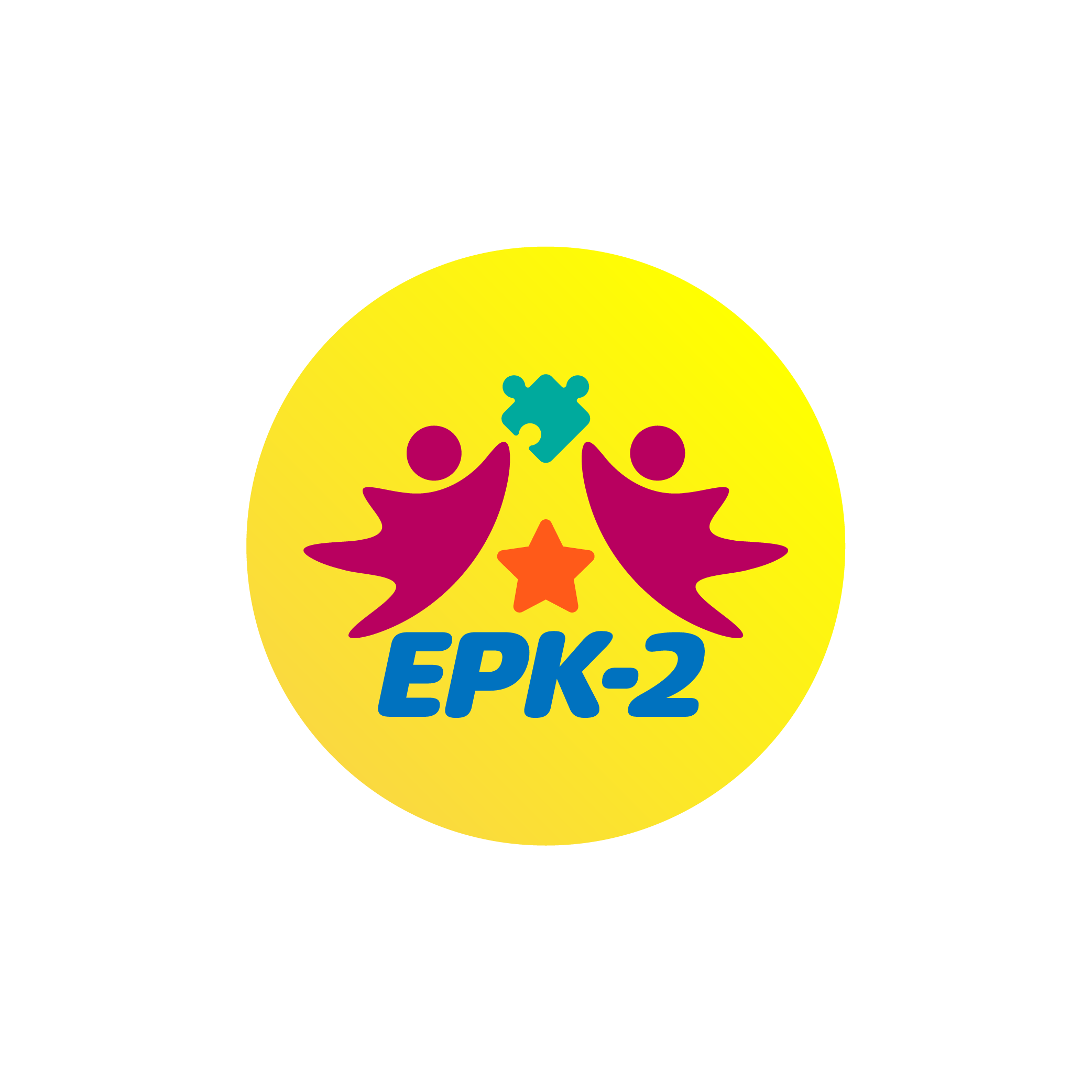 Exploring Early Childhood Teachers’ Abilities to Identify Computational Thinking Precursors to Strengthen Computer Science in Classrooms
Exploring Early Childhood Teachers’ Abilities to Identify Computational Thinking Precursors to Strengthen Computer Science in Classrooms
PI: Sean Justice
Grades: PreK–2
STEM Disciplines: Technology (Computer Science)
Project Description: EPK-2 developed and tested an expressive STEM professional development model that transformed how early childhood teachers understood and implemented computational thinking (CT). We introduced CT as multimodal meaning making that supported their development of algorithmic thinking and debugging skills, among other CT skills. After participating in the program, teachers positioned themselves as facilitators of student-centered learning communities, where computational tools and materials became one among many ways of engaging with the curriculum in their classrooms.
The project centered on a summer computing institute where teachers became learners themselves, working with tools like robotics and visual programming platforms to explore CT. Unlike unplugged CT activities that teach computing concepts without computers, teachers learned to anchor new computational skills to CT precursors—everyday ways of thinking and problem-solving that they and their students already possessed, such as following step-by-step instructions or breaking tasks into smaller parts. This asset-based approach positioned computational tools as extensions of existing strengths rather than separate, abstract skills to be learned from scratch.
Over four years, we worked with 51 teachers across three cohorts, documenting increases in teacher confidence and shifts in professional identity. Teachers adopted asset-based approaches, positioned students as classroom experts, created collaborative learning environments, and facilitated inquiry-driven exploration.
Findings revealed that teachers implemented CT across the curriculum, embedding computational concepts into literacy, math, social-emotional learning, and other domains. The project’s impact extended beyond the original research site because the EPK-2 model has been adapted and implemented in additional districts. (WC 244)
What theoretical framework(s) are you using to guide your work?
EPK-2 draws on three interconnected frameworks and introduces a fourth: generative learning theory, material inquiry, sociomaterialism, and CT precursors. As an approach, our articulation of CT precursors distinguishes asset-based engagement with computational tools from approaches that treat computing as discrete sets of separate skills. This approach offers a foundation for what could become, with further development, a framework for making Bers’ (2021) Powerful Ideas more actionable, assessable, and collaborative in classroom practice.
Generative learning theory (Assaf et al., 2016; Ball, 2009) positions teacher learning as self-perpetuating change where educators continuously redesign practices by integrating professional knowledge with insights about student learning. Material inquiry (Justice, 2020) and sociomaterialism (Hawley, 2022) work together to leverage “purposeful play,” where serendipitous encounters with computational tools—moments when materials contribute unexpected learning opportunities—catalyze teacher learning through hands-on exploration with tools and materials as active learning participants.
Reflection on EPK-2 has led us to synthesize these frameworks into what we now term expressive STEM—a pedagogical approach building on existing knowledge to spark collaboration and meaning-making in STEM learning. Drawing from multimodal literacy research, this approach positions learning as engaging through diverse means—books, images, digital encounters, performance, and art—where multimodal engagement sparks ‘literacy desirings’ (Justice & Assaf, 2024, referencing Kuby & Rucker, 2016).
What models or techniques are you researching and developing that are specific to this age range?
EPK-2 is developing a framework based on 'CT precursors'—everyday capacities for making sense of individual and social experience—to engage CT abilities that young children (and adults) already possess. This asset-based approach aligns with culturally responsive pedagogy and generative learning theory, where effective teaching builds on students’ existing knowledge and cultural strengths (Assaf & Justice, 2024). Drawing from Bers’ (2021) Powerful Ideas framework, CT precursors might include creating step-by-step instructions (algorithms) and understanding that traffic lights guide behavior (control structures). At the EPK-2 institute and during classroom coaching sessions, teachers learned to identify and build upon precursors to create lessons across disciplines, e.g., math, science, history, SEL, during playtime, and in reading/writing explorations. Some teachers adapted computational making activities from the summer institute, blending digital tools with traditional art materials in map making and bookmaking. In this way the precursor approach helped teachers recognize their existing computational capacities, giving them confidence to take creative risks with unfamiliar tools like robots and circuit-building materials, along with coding platforms, which they then adapted for their specific classroom contexts and student needs.
What is something you think is important for the broader community (other STEM education researchers, policymakers, industry representatives, and/or the public) to know about early STEM learning?
Young children bring multiple strengths to their learning. As good teachers know, children already know how to do a lot of different things by the time they show up in the classroom, including things connected to computing, like giving step-by-step instructions, imagining approaches to solving problems, and recognizing patterns. Across multiple domains (e.g., reading and writing, math, social emotional learning, etc.), teachers know their job is to engage the strengths children bring with them to expand and strengthen knowledge, not only for those individual students but for the entire classroom community.
In the domain of computer science, EPK-2 described what children already know and know how to do as CT precursors. Unlike so-called “unplugged” activities that teach computing concepts without computers, calling on CT precursors recognizes computational thinking capacities that children already demonstrate in their everyday problem-solving and sense-making. As antecedents to the full-fledged computing fluencies that might develop if children had opportunities to engage with computational tools and materials in multimodal learning environments, precursors suggest concrete ways of knowing that teachers can recognize and nurture in their classrooms.
This emphasis on opportunities with tools and material is important. We learn to write by writing. Or more accurately, by having opportunities to tell and retell stories by marking down, drawing out, building up, and dramatizing our stories. More broadly, we learn to make multimodal meaning when we have opportunities to work with different kinds of tools and materials to explore questions and problems that interest us.
By this more inclusive view, it make sense that computational thinking does not develop in isolation, as an esoteric skill. Rather it emerges as part of a vast spectrum of potential ways of thinking and knowing, just one component among many.
At EPK-2 we wanted to know if introducing teachers to CT by emphasizing computing as one among many ways to tell stories, make art, or do science would encourage them to find space for it in their classrooms. We reasoned that by introducing computation as playful engagement with stories, robots, circuits, and programming, not as an abstract logical exercise, teachers themselves might want to bring computing into their classrooms. And that turned out to be true—when teachers recognized that the precursors of computing already existed in their classrooms, they felt empowered to give computing a try—because they themselves were already facilitating computational thinking through their existing teaching practices but hadn’t named it or connected it to computing.
Here, the notion of precursors helps clarify what’s missing in computer science education frameworks that either assume children lack computational knowledge or claim they’re already computational thinkers without computers. Our findings demonstrate that when teachers built on children’s existing strengths while encouraging them to work with computational tools, they reported high levels of engagement and collaboration across multiple subject areas. Teachers consistently observed students helping each other, taking leadership roles, and connecting computational concepts to literacy, math, and social-emotional learning, among other subjects. This new perspective challenges assumptions that early childhood education should delay computational engagement and offers a new way forward—where the notion of precursor might inform curriculum approaches that integrate CT with the existing learning objectives in early childhood education.
Bottom line, EPK-2 revealed that when computational tools and materials were approached as just another set of resources for collaborative storymaking and community building, teachers reported enhanced learning from their early elementary students, across multiple domains. This emboldened teachers to try harder and go further with their own computational learning, for the sake of their students, because they knew computing strengthened fluencies across the board, both for individual children and for the whole classroom community.
Initial Project Findings: EPK-2 produced significant quantitative and qualitative findings demonstrating the effectiveness of expressive STEM approaches in early childhood computational thinking education.
A. Teacher Learning and Confidence: The Teacher Beliefs about Coding and Computational Thinking survey (TBaCCT; Rich et al., 2020) administered to 51 teachers across three cohorts showed statistically significant gains in all measures of computational thinking confidence and self-efficacy. Pre- to post-institute improvements included very large effect sizes for Coding (Cohen’s d = 1.95) and Teaching (d = 2.10) subscales, with large effects for Value (d = 0.79) and Computational Thinking (d = 0.80) measures (all p < .0001).
B. Pedagogical Transformation: “After doing the institute and realizing I don’t have to know everything to get started, and I could learn along with the kids, that was a huge mind-change.” (Elementary specialist)
Teachers adopted asset-based pedagogies without explicit instruction to do so, fundamentally transforming their professional identities. Classroom observations and interviews revealed teachers repositioning themselves from knowledge authorities to collaborative facilitators, positioning students as experts, encouraging peer-to-peer teaching, and shifting from direct instruction to inquiry-based facilitation. Teachers consistently used inclusive language (“we,” “us,” “our”) and created collaborative learning environments where students helped each other debug code and solve computational problems.
“It’s okay that I’m not the teacher. I think that was the main thing I got out of the [program]. That I’m not the answer of all things. And so, really taking a step and being just somebody on the side and having them learn through each other.” (Kindergarten teacher)
C. Cross-Curricular Integration: Teachers embedded computational thinking across multiple subjects, particularly literacy, mathematics, and social-emotional learning. Teachers reported that CT activities enhanced student collaboration and engagement more than traditional direct-instruction methods.
“Representation is [now] a little bit more a part of our vocabulary.” (Kindergarten teacher describing how students used ScratchJr to demonstrate sight word understanding)
D. Sustained Implementation: Follow-up data showed continued use of CT practices beyond the formal intervention period. Teachers maintained inquiry-driven approaches and continued positioning themselves as co-learners with students.
E. Student Engagement: Teachers consistently reported high levels of student engagement during CT activities, with students taking leadership roles and demonstrating computational concepts through storytelling, visual programming, and robotics projects.
“When they were given their own box with their own KIBO, I just saw fireworks. It was just, ‘Let’s do this’, and ‘Let’s do that.’“ (Pre-Kindergarten teacher)
“What I learned about it—in the sense of debugging—...[was] how well they used their language to collaborate with each other and try and debug [together].” (Kindergarten teacher)
Products
Website: https://epk2.wp.txstate.edu/
Publications:
- Assaf, L. C. & Justice, S. (2024). Asset-based computational thinking in early childhood classrooms: Centering students’ expertise in a community of learners. Early Childhood Education Journal. https://doi.org/10.1007/s10643-024-01825-3
- Justice, S. & Assaf, L. C. (2024). Expressive STEM storymaking: Art, literacy, and creative computing. In A. Lai & Y. Cooper (Eds.), STEAM education: Intersections and thresholds (pp. 210-226). Brill. https://doi.org/10.1163/9789004714748_014
Conference Presentations:
- Assaf, L. C. & Justice, S. (2024). Early childhood teachers’ use of asset-based computational thinking pedagogy: Centering students’ expertise and life experiences. American Educational Research Association National Conference, Philadelphia, PA.
- Justice, S. & Assaf, L. C. (2025). An expressive STEM approach to computational thinking teacher professional development. American Educational Research Association National Conference, Denver, CO.
- Justice, S. & Assaf, L. C. (2023) EPK-2 Exploring Early Childhood Teachers’ Abilities to Identify Computational Thinking Precursors to Strengthen Computer Science in Classrooms. National Science Foundation DRK-12 PI Conference, Washington, DC.
- Assaf, L.C. & Justice, Sean (2022). Computational Thinking and Literacy: Understanding Teachers’ Approaches to Leveraging CT and Literacy Across Early Childhood Classrooms. 72nd Annual Literacy Research Association Conference, Phoenix, Arizona.
- Assaf, L. C.& Justice, J. (2022). Multimodal Approaches to Literacy: Exploring Precursors to Computational Thinking with Primary Grades. European Literacy Association Conference Dublin.
- Justice, S. & Assaf, L. C. (2021). Computational Thinking and Generative Self-Efficacy in Multimodal Approaches to Literacy. 71st Annual Literacy Research Association Conference, Atlanta, November 30-December 5, 2021.
Educational Models and Tools (for practitioners):
- EPK-2 CT Lesson Cycle [Model]
- EPK-2 Teacher Beliefs about and Dispositions toward Coding and Computational Thinking [Survey, adapted from Rich et al, 2020]
- Computational Making and Inquiry Institute (CMII), aka Summer Computing Institute, a professional development model
- CT Precursors framework and identification guide.
Videos (for practitioners):
- See Through KIBO [Video]. YouTube. https://youtu.be/6x-RojSf8rk
- See Through ScratchJr [Video]. YouTube. https://youtu.be/Y2T5ktGFS90
Suggested Reading:
- Bers, M. U. (2021). Coding as a playground: Programming and computational thinking in the early childhood classroom (2nd ed.). Routledge.
- Resnick, M. (2017). Lifelong kindergarten: Cultivating creativity through projects, passion, peers, and play. MIT Press.
- Kuby, C. R., & Rucker, T. G. (2016). Go be a writer!: Expanding the curricular boundaries of literacy learning with children. Teachers College Press.
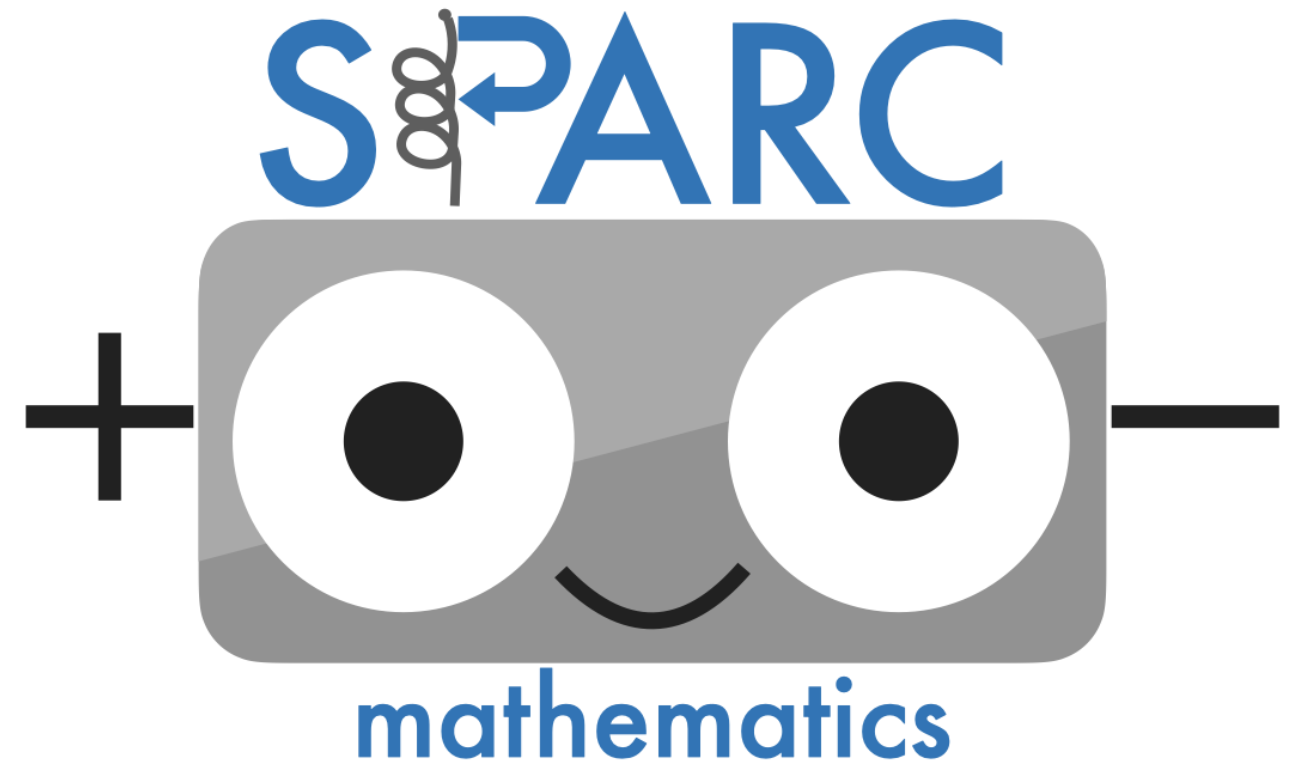 Investigating Early Elementary Students' Computational Thinking Development in Integrated Mathematics-Coding Instruction
Investigating Early Elementary Students' Computational Thinking Development in Integrated Mathematics-Coding Instruction
PI: Jessica Shumway
Grades: 1–2
STEM Disciplines: Mathematics, Technology (Computer Science)
Project Description: The SPARC-Math (Spatial Activities and Robot Coding for Mathematics) Project is a development project focused on three key activities:
- Empirically developing a computational thinking (CT) learning trajectory for grades 1–2,
- Operationalizing CT for students in grades 1–2, and
- Developing aligned instruction and assessment for integrated CT and mathematics learning
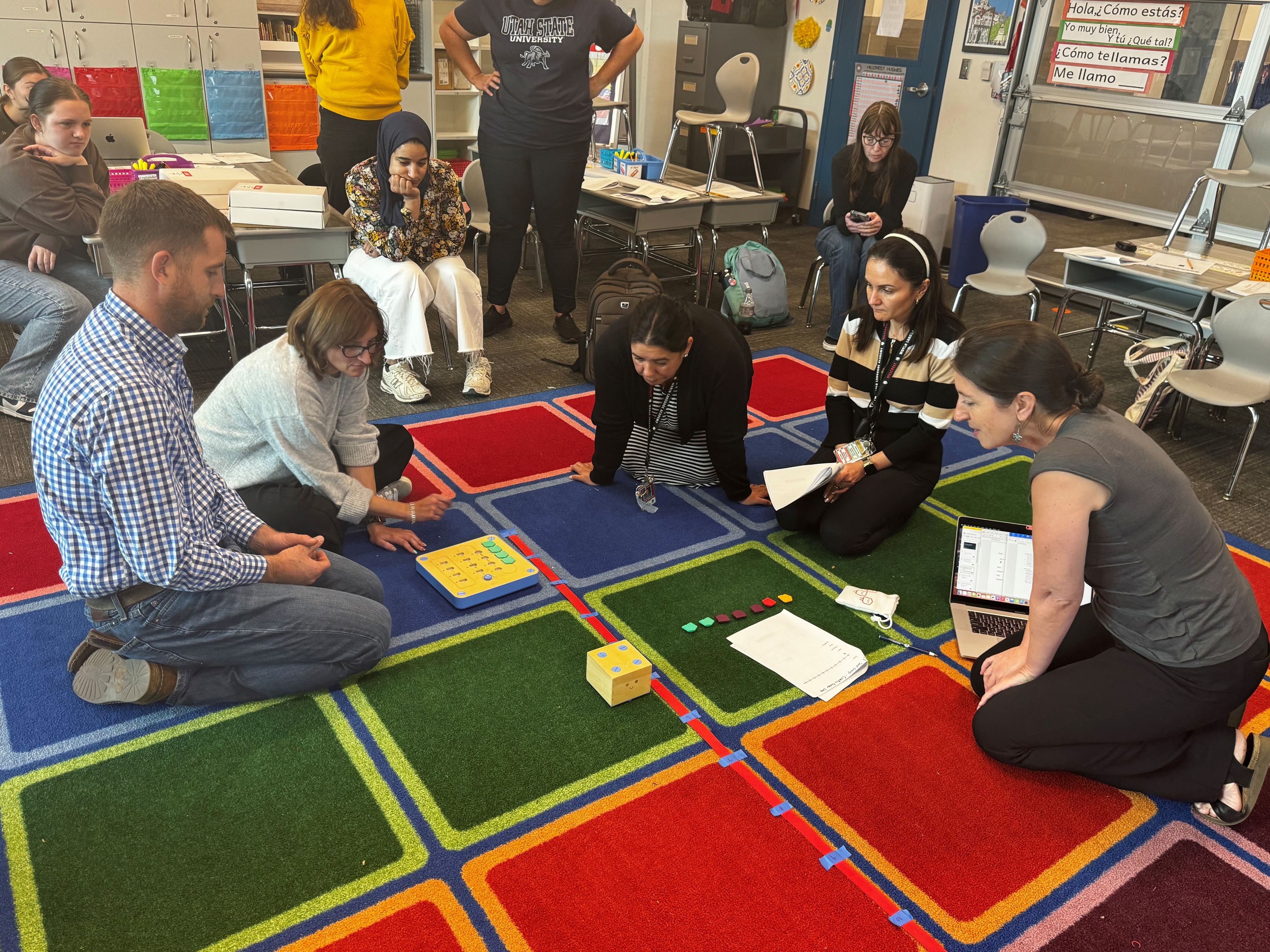 To achieve this, we are designing and testing a research-based model of early childhood CT grounded in extensive classroom observations of how children’s thinking develops. Using tangible coding toys like Cubetto, Botley, and Dash, we explore how young children build foundational CT skills such as algorithmic thinking, debugging, and decomposition. Our approach integrates CT with key mathematical concepts—like spatial reasoning, sequencing, and unit measurement—and emphasizes how children coordinate code with physical movement on grid-based paths. We iteratively develop lessons, tasks, and assessment tools aligned with the developmental needs of young learners.
To achieve this, we are designing and testing a research-based model of early childhood CT grounded in extensive classroom observations of how children’s thinking develops. Using tangible coding toys like Cubetto, Botley, and Dash, we explore how young children build foundational CT skills such as algorithmic thinking, debugging, and decomposition. Our approach integrates CT with key mathematical concepts—like spatial reasoning, sequencing, and unit measurement—and emphasizes how children coordinate code with physical movement on grid-based paths. We iteratively develop lessons, tasks, and assessment tools aligned with the developmental needs of young learners.
As an extension of our Coding in Kindergarten project (NSF STEM+C #1842116) which produced and validated a CT assessment for kindergarten students based on an integrated spatial and CT model, we continue to operationalize CT through direct observation, design-based research, and alignment with mathematics learning trajectories with students in grades 1–2. We aim to offer educators a robust framework and curriculum for teaching coding and CT in early learning environments. Ultimately, this project expands the boundaries of early STEM education and lays the groundwork for engaging computational learning from the earliest years of schooling.
What theoretical framework(s) are you using to guide your work?
For the design of the learning trajectories, we draw on Hierarchical Interactionism, which models the developmental progressions of children’s thinking. Complementing this, our analysis of classroom activity is informed by sociocultural theories, including Activity Theory and semiotic mediation, allowing us to examine how learning is mediated by social interaction, language, and tools.
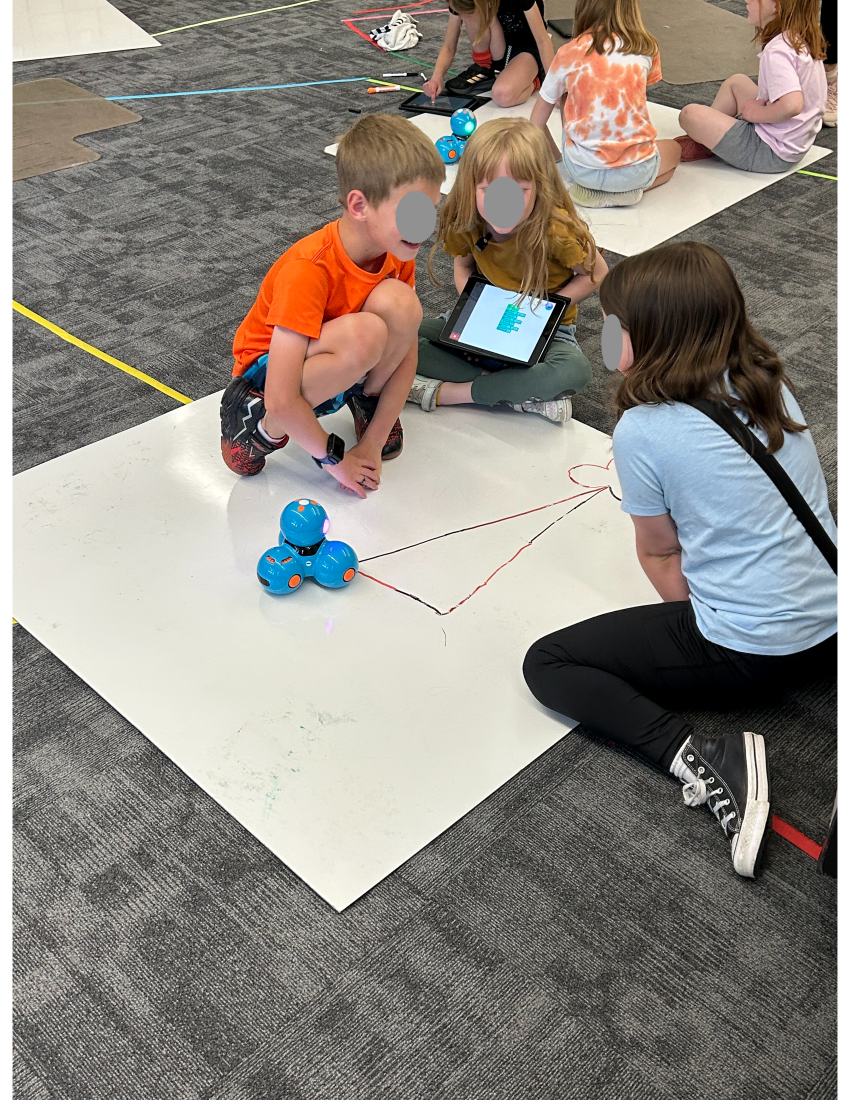 What models or techniques are you researching and developing that are specific to this age range?
What models or techniques are you researching and developing that are specific to this age range?
We use design-based research to observe children’s interactions—with the robot coding toys and with each other—gestures, movements, and language. Our multi-modal data (video of children solving tasks) capture the multi-modal ways of meaning-making.
What kinds of partners did you involve to support your work in PreK–3 learning environments?
We work with a design team comprised of five first- and second-grade teachers. We meet six times a year and have worked together to co-design lessons.
Initial Project Findings
- A case study on the integration of CT and mathematics revealed that students engaged with multiplicative thinking (i.e., composite units, doubling, iterating) while working with the coding robots (Shumway et al., 2025).
- In a different case study, analysis of one student's progression showed a shift in her understanding of loops from single steps to repeated actions, highlighting the role of hands-on tasks and peer interaction in overcoming challenges with robot syntax (Ashineh et al., 2025).
- We also identified emerging socio-computational norms in the classroom, as students navigated tensions between creating novel solutions and building upon existing ideas (Silvis, Ashineh et al., 2025; Silvis, Clarke-Midura et al., 2025).
Products
Website: https://digitalcommons.usu.edu/sparc/
To date, results have been disseminated to various stakeholders (e.g., teachers and researchers) through conference presentations, proceedings, and a webinar. (*=student; ***=teacher)
Practitioner Conference:
- *Lund, C., Shumway, J. F., Braden, S., *Yazidi Alaoui, A., Clarke-Midura, J., Silvis, B., & Lee, B. (2025, June). Integrated Mathematics-Coding Tasks for Content-Based Language Instruction. The 4th Working CLIL (Content Language and Integrated Learning) International Colloquium, Castelo Branco, Portugal.
Conference Proceedings:
- Clarke-Midura, J., Shumway, J. F., *Ashineh, A., *Zandi, A., & **Clawson, W. (2024, June). What happened to the geometry? Examining spatial and mathematical concepts in computational toys and kits for young children. In Proceedings of the Symposium on Learning, Design and Technology, pp. 47-56.
- Silvis, D., Ashineh, A., Lee, B., Shumway, J. F., & Clarke-Midura, J. (2025, June). Find it first, don’t cheat, make your code useful: Norming “Novelty” in early childhood computer science. In Proceedings of the International Society of the Learning Sciences (ISLS) (pp. 350–358). Helsinki, Finland.
- Lee, B., Shumway, J. F., Clarke-Midura, J., Silvis, D., Ashineh, A., & Lund, C. (2025, July). First-grade students’ ideas around negative numbers in mathematics-coding integrated lessons. In Proceedings of the 9th ICMI-East Asia Regional Conference on Mathematics Education (EARCOME) (pp 1005-1010). Siheung, Korea.
Conference Presentations:
- Shumway, J. F., *Lund, C., ***Kozlowski, J., Silvis, D., Clarke-Midura, J., & *Ashineh, A. (2025, April). Locking-It-In and Doubling: Mediating Second-Grade Students’ Activity with Multiplicative Thinking. [Roundtable Session]. Annual Meeting of the American Educational Research Association (AERA), Denver, Colorado.
- *Ashineh, A., Clarke-Midura, J., Silvis, D., Shumway, J. F., ***Kozlowski, J., & *Lund, C. (2025, April). Navigating Multiplicative Reasoning as Loops: Students’ Meaning-making of Integrated Elementary Mathematics and Computer Science Lessons. [Poster]. Annual Meeting of the American Educational Research Association (AERA), Denver, Colorado.
- Silvis, D., Clarke-Midura, J., Shumway, J. F., *Ashineh, A., & *Lund, C. (2025, April). “We Had an Amazing Idea, but Then Someone Already Had It”: Norming Novelty in Early Childhood Computer Science. [Poster]. Annual Meeting of the American Educational Research Association (AERA), Denver, Colorado.
- *Ashineh, A., Clarke-Midura, J., Silvis, D., Shumway, J. F., ***Kozlowski, J., & *Lund, C. (2025, March). Developing a Hypothetical Learning Trajectory for Loops in Integrated Math-CS Lessons [Poster]. Annual Meeting of Learning, Instruction, and Technology Conference 2025 (LIT), Utah State University, Logan, Utah.
- Ashineh, A., Clarke-Midura, J., Shumway, J. F., J., Silvis, D. (2024, April). Coding and Math in Elementary School Relationships Among Mathematical, Spatial, and Computational Thinking [Poster]. Annual Meeting of The Student Research Symposium (SRS), Utah State University, Logan, Utah.
- *Ashineh, A., Clarke-Midura, J., Silvis, D., Shumway, J. F., ***Kozlowski, J., & *Lund, C. (2025, March). Developing a Hypothetical Learning Trajectory for Loops in Integrated Math-CS Lessons [Poster]. Annual Meeting of Learning, Instruction, and Technology Conference 2025 (LIT), Utah State University, Logan, Utah.
Invited International Webinar:
- Shumway, J. (2025, May 19). Invited by Dr. Eva Brooks at Aalborg University, Denmark to lead a webinar titled Using Robot Toys to Play with Math, Space, and Coding as part of the Computation Play Nordic Initiative webinar series in Denmark, Sweden, Norway, and Finland.
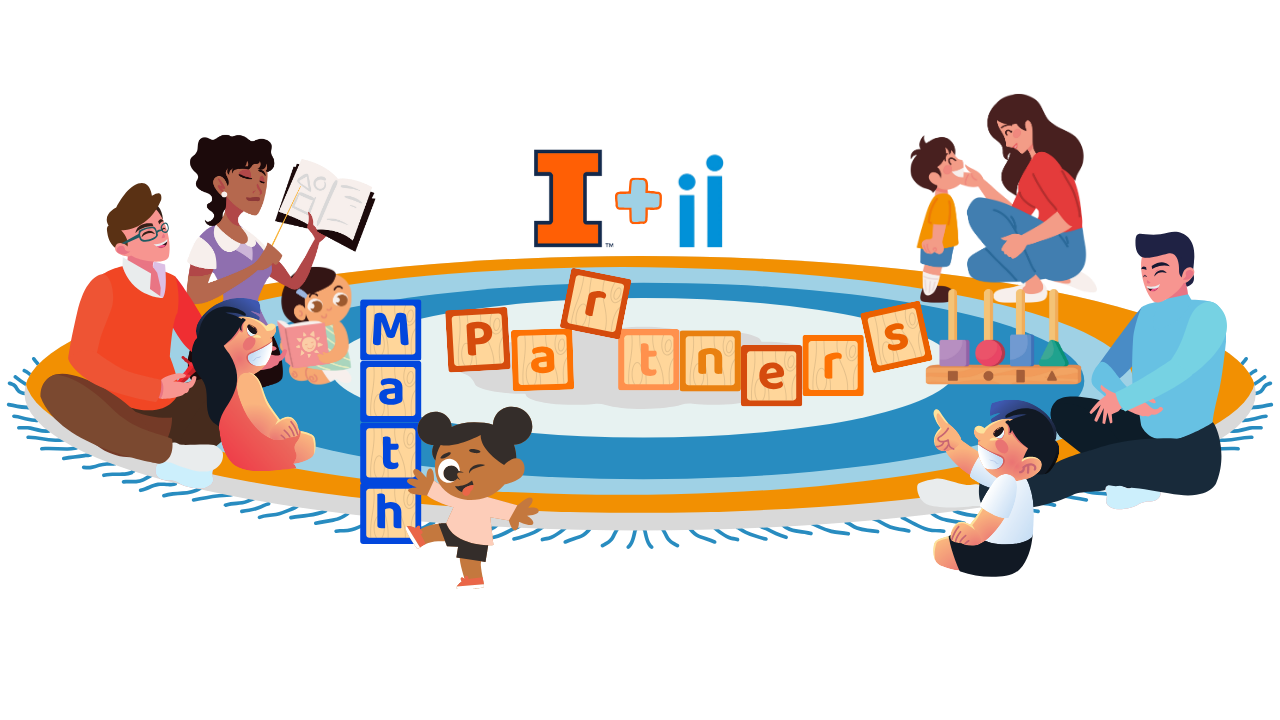 Math Partners: Collaborations to Support Early Math Learning
Math Partners: Collaborations to Support Early Math Learning
PI: Stephanie Smith
Grades: PreK
STEM Disciplines: Mathematics
Project Description: Math Partners: Collaborations to Support Early Math Learning is an ongoing project focused on developing an intervention to support teachers and families in working together to support early math learning. A primary goal of the project is to develop collaborative dual-partnerships in which teachers and families work together, learn from each other, and provide complementary math learning experiences at home and at school. As a design and development project, Math Partners includes four phases—an initial design phase, a field test, a pilot employing a randomized controlled design in collaboration with 15 treatment and 15 control classrooms, and a dissemination phase. In our current work in Phase 1, the research team and participating teachers and families from across three local schools are working together in two ways: in classroom design teams and small-group coaching. The design teams are developing mechanisms for teachers and families to work together, including procedures for bidirectional communication, virtual home visits, and classroom stay-and-plays. In the coaching team, researchers, including a coach, are working with a small group of teachers to develop action plans designed to help them build stronger partnerships with families and provide high-quality math activities and instruction in the classroom.
In this project, we are working with teachers and families in our local community to develop home and school math experiences in design teams and with teachers to try new classroom practices with support of Practice-based Coaching.
What theoretical framework(s) are you using to guide your work?
Math Partners draws from the Dual-Capacity Framework first proposed by Mapp and Kuttner in 2013 and then revised in 2019. Mapp and Bergam (2019, 2021) call for the development of dual-capacity partnerships in which teachers work collaboratively with families to better involve them in their children's education. This model takes a strengths-based approach to family engagement in which teachers focus on what families can do rather than what they do not have or cannot do. To this end, teachers focus on the development of process conditions such as mutual trust, focus on assets, respectful collaborations, and connections to learning and development. Schools must consider organizational conditions, such as practices that are embraced across the school or district, integrations of strategies in practice, and how practices can be sustained. These conditions build knowledge and skills, connections, shifts in beliefs, and confidence, leading to educators who are empowered to collaborate with families and families who are willing to take on diverse roles in schools.
What models or techniques are you researching and developing that are specific to this age range?
Math Partners is focused on pre-school level mathematics education. Teaching and learning math at this level is decidedly different than what most math education looks like. Specifically, just as preschool children are not expected to read and write with the alphabet, they are not yet ready to read and write numerals. In this context, teaching and learning activities focus on spoken language by both teachers and children and the use of hands-on and visually represented materials. In the Math Partners Design Team experience, teachers and families study how young children’s understanding of three math content areas—sets and sorting, number sense, and patterns—develops during the preschool years and focus together on ways to help children learn to think mathematically. Storybooks, games, and table-top manipulatives are featured alongside discussions of language adults can use to help “mathematize” children’s everyday experiences.
What knowledge, skills, or other outcomes is your project focused on supporting and/or measuring?
In this project, we are using Practice-based Coaching to support teachers. The coach works with a small group of teachers to help them build their knowledge and skills around math instruction and family partnerships. We are studying our innovations to this coaching approach, which includes guided action plans, video observations, and peer feedback.
What kinds of partners did you involve to support your work in PreK–3 learning environments?
In order to both develop and test our materials, we are working with a small set of teachers and parents from three local preschools. All three schools are public and run by local school districts.
What are the unique challenges related to your work in this age range and what strategies has your project identified for addressing them?
Most adults do not have an in-depth understanding of how children’s mathematical thinking develops. To help teachers and families work on Math Partners together, we are providing three hands-on learning labs that focus on early math.
Suggested Resources:
- Erikson Institute Early Math Collaborative
- STEM Innovation for Inclusion in Early Education (STEMIE) Center
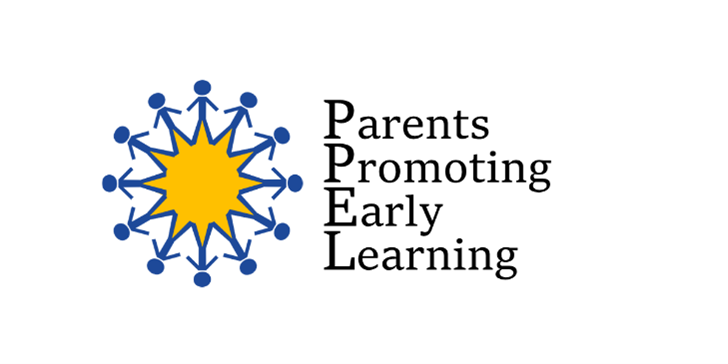 Number and Spatial Skill Development from 2 Years to 2nd Grade: Examining Associations with Home Math Environments in Early and Middle Childhood
Number and Spatial Skill Development from 2 Years to 2nd Grade: Examining Associations with Home Math Environments in Early and Middle Childhood
PI: Heather Bachman
Grades: 1–2
STEM Disciplines: Mathematics
Project Description: Past research typically examines home math activities, or parent talk about math and spatial concepts, during the preschool years. However, during elementary school, it is unclear how parents balance greater academic rigor and homework assistance, increasing digital media use, and home math activities to support children’s continued math learning. This study examines children’s number and spatial math development in the context of families’ home math environments to identify areas of stability and change in parental support of children’s math learning beginning in toddlerhood through 1st and 2nd grades.
This project draws data from a longitudinal study of 30-month-old children (N = 320) and their parents and follows them into early elementary school. First, multi-method measurement of the home math environment (HME) will be collected in middle childhood. Second, associations between the 1st grade home math environment and gains in math skills from 1st to 2nd grade will be examined. Third, continuity in children’s number and spatial math skills from early childhood to middle childhood will be investigated. Fourth, this study will examine whether early childhood math skills and HME and grade 1 HME uniquely predict middle childhood math skills. Children will complete math assessments during two home visits in 1st and 2nd grades. A combination of structured observations, surveys, and time diary interviews will measure children’s home math environment. The 1st and 2nd grade data will be linked to early math skills and HME measures collected at ages 2 and 3 in the Parents Promoting Early Learning project (DRL 1920545).
What theoretical framework(s) are you using to guide your work?
The present study integrates theoretical perspectives from multiple disciplines to guide the study aims and methods. The focus on the home math environment (HME), as a key contributor to children’s early math learning, is grounded in bioecological models of child development, which argue that development is driven by interactions and experiences within children’s proximal environments. To guide our examination of children’s proximal HME, the current proposal is also informed by academic socialization models, which differentiate parents’ involvement in practices that support learning at home, including enrichment activities, conversations, and media, and their involvement with children’s formal schooling, such as homework assistance. In addition, the proposed study is longitudinal, examining children’s math skills and evolving home math environments across early and middle childhood. Dynamic systems theory points to the complexity of relationships unfolding over time, with children and their environments influencing each other over time as children mature and gain more skills. Similarly, economics provides an accumulation of inputs framework, whereby children’s additive experiences in their family throughout early and middle childhood shape academic growth during elementary school.
What knowledge, skills, or other outcomes is your project focused on supporting and/or measuring?
We are administering a wide range of assessments to measure STEM-related skills and developmental correlates: (1) Number Skills, including arithmetic, measurement, early fraction knowledge, money knowledge; (2) Spatial Skills, including mental rotation and spatial relational language; (3) Executive Function and Self-Regulation skills; (4) Reading and Reading Comprehension skills; and (5) a brief child interview about their math beliefs, attitudes, and anxiety.
What is something you think is important for the broader community (other STEM education researchers, policymakers, industry representatives, and/or the public) to know about early STEM learning?
The importance of the home learning environment to support children's math learning in informal contexts. Our work is identifying a variety of parental supports for math learning from toddlerhood to early elementary school, including the frequency and diversity of play-based math activities and conversations about math concepts.
Suggested Reading:
- Clements, D. H. & Sarama, J. (2005). Math Play. Scholastic Early Childhood Today, 12, 50-57.
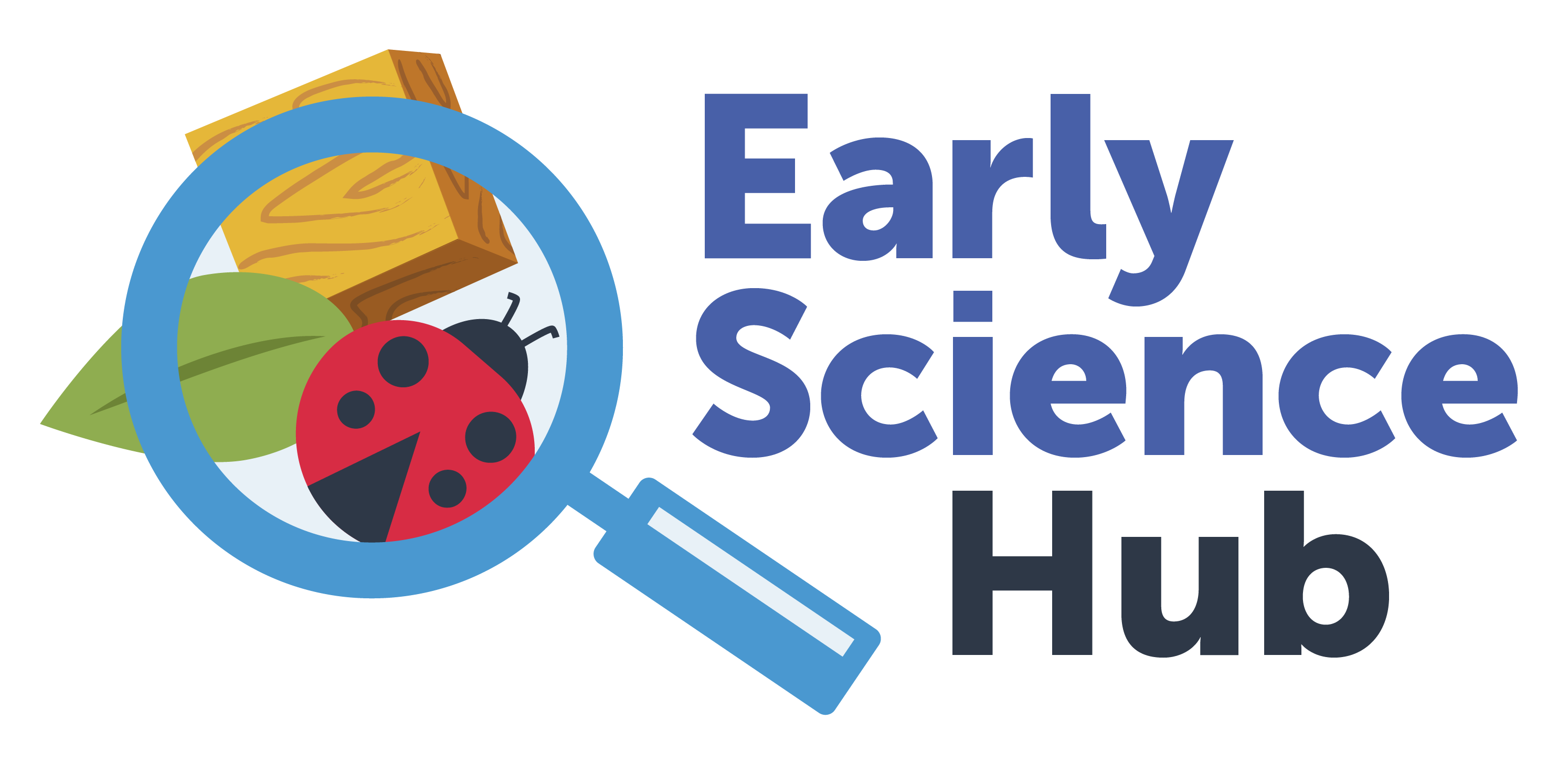 Professional Learning Hub for Early Science (HubES): Leveraging Technology to Develop Supports for Educators to Promote Meaningful Science Learning in Preschool
Professional Learning Hub for Early Science (HubES): Leveraging Technology to Develop Supports for Educators to Promote Meaningful Science Learning in Preschool
PI: Ximena Dominguez
Grades: Preschool/PreK
STEM Disciplines: Science
Project Description: This collaborative DRK12 project engages public preschool educators and families, designers of edtech, and early childhood researchers in a co-design process to develop a professional learning resource to equip teachers with the knowledge and instructional skills needed to meaningfully and effectively promote science in early learning classrooms. During the current phase of work, the team is building relationships to brainstorm, design, pilot, and refine four key components of the Early Science Hub: 1) a science practices video and resource library to showcase the different science practices in action, 2) digital interactives with simulations and educative components that can help teachers develop a robust understanding of science core ideas that can be promoted in preschool, 3) an interactive cross-disciplinary map to highlight evidence-based links between science and other learning domains, such as math, literacy, and approaches to learning, and 4) a home-school toolkit to help preschool educators connect science learning across home and school. The next phases of work will involve two field studies to examine implementation and the promise of the Early Science Hub.
What kinds of partners did you involve to support your work in PreK–3 learning environments?
Our work includes close partnerships with preschool teachers (and children and families in their classrooms). The effort’s collaborative approach is an integral part of the design process to ensure that the resulting Early Science Hub resources authentically reflect the strengths of preschool teachers and communities and align with their everyday experiences.
What is something you think is important for the broader community (other STEM education researchers, policymakers, industry representatives, and/or the public) to know about early STEM learning?
Research over the past decade has shown that young children are not only naturally interested in making sense of the world around them, but also capable of engaging in rich science investigations that can prepare them for later science learning and positively influence their learning broadly. Early STEM experiences provide meaningful opportunities for children to explore their curiosity, ask questions and investigate how things work in playful ways. Science activities promote collaboration and problem-solving – both critical skills needed across PreK-12 contexts and beyond. While curricular resources have been designed to support young children’s science learning, efforts to create professional learning resources for teachers are needed. Our project leverages technology to create resources that can be feasible used by preschool programs and diffused broadly.
Products:
- Early Science Hub Website (Practitioner facing)
- What Does the Research Say? 3 Guidelines for Designing STEM Opportunities for Early Learners (Digital Promise blog post)
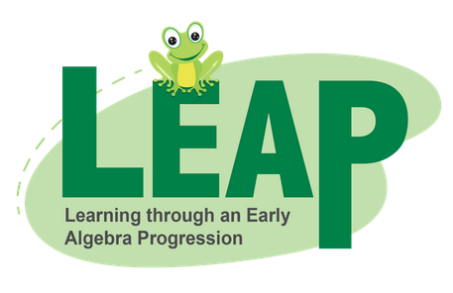 The Impact of an Inclusive Grades K–2 Early Algebra Intervention Implemented by Classroom Teachers
The Impact of an Inclusive Grades K–2 Early Algebra Intervention Implemented by Classroom Teachers
PI: Maria Blanton
Grades: K–2
STEM Disciplines: Mathematics
Project Description: The Impact of an Inclusive Grades K–2 Early Algebra Intervention Implemented by Classroom Teachers is a large-scale, randomized study of the effectiveness of the Grades K–2 early algebra “LEAP” curriculum when taught by elementary teachers as a supplement to their regular mathematics instruction. The three-year longitudinal study is currently being implemented in 40 schools and follows a cohort of students from kindergarten through Grade 2. The LEAP curriculum develops children’s algebraic thinking around four key practices: Generalizing, representing, justifying, and reasoning with mathematical structure and relationships. The development of children’s algebraic thinking beginning in kindergarten promises to help address the excessive failure rates in high school algebra that have resulted from more traditional “arithmetic-then-algebra” approaches. Current math curricula in the elementary grades do not adequately develop children’s algebraic thinking. Effective models of early algebra instruction are needed, particularly for students from underserved communities who typically have less access to the kinds of curricula and instruction that can lead to success in algebra. Understanding the LEAP curriculum’s effectiveness and how teachers might implement it with fidelity for diverse learners is essential to broadening participation in STEM disciplines. The Grades 3–5 LEAP curriculum developed in prior research has been shown to significantly increase students’ algebra readiness for middle grades, including for students from low-resourced communities. The combined Grades K–5 LEAP curriculum promises to provide teachers with an effective curricular roadmap for building all children’s algebraic thinking.
What theoretical framework(s) are you using to guide your work? Methodologically, we have used a learning progressions research paradigm to guide the development of our LEAP curriculum for Grades K–2 (and prior to this, for Grades 3–5). Learning progressions are increasingly endorsed for their potential to inform the design of coherent standards, curricula, assessment, and instruction (e.g., Daro, Mosher, & Corcoran 2011*). Based on this approach, we developed (1) a curricular framework and subsequent learning goals regarding core algebraic concepts and practices at Grades K–2; (2) a Grades K–2 instructional sequence (supplemental curriculum) aligned with this framework; and (3) validated, grade-level assessments that could be used to measure students’ learning in response to the instructional sequence.
Our conceptual framework for early algebra has guided the development of the content in our early algebra intervention. In short, this framework characterizes early algebra in terms of four key practices: Generalizing, representing, justifying, and reasoning with mathematical structure and relationships. The LEAP curriculum focuses on developing these mathematical ways of thinking.
What knowledge, skills, or other outcomes is your project focused on supporting and/or measuring?
We are measuring the effectiveness of our curriculum in developing children’s capacity to generalize, represent, justify, and reason with mathematical structure and relationships. This has specific instantiations, such as students’ relational understanding of the equal sign, their ability to represent mathematical relationships in words and variables, and their ability to develop viable (representation-based) mathematical arguments to show general claims are true.
What kinds of partners did you involve to support your work in PreK–3 learning environments?
To support our work in K–2 classrooms, we partnered with three school districts in the southeastern United States. Establishing these partnerships required sustained effort, as districts face significant challenges, including overextended teachers, limited resources, and competing curricular demands. Despite these constraints, the districts we work with share a strong commitment to improving math instruction and outcomes for their youngest learners. Their willingness to participate and engage deeply with our project reflects a shared belief in the importance of early algebra and the desire to expand opportunities for students. Their partnership has been invaluable in implementing and sustaining a meaningful change in early math education.
What are the unique challenges related to your work in this age range and what strategies has your project identified for addressing them?
One unique challenge of our work with K–2 students is the pervasive misconception that young learners are not developmentally ready to engage in algebraic thinking. This skepticism can lead to resistance among educators and stakeholders, making it critical to build both understanding and buy-in. To address this, we have developed a robust professional development (PD) model that supports teachers in navigating the complexities of early algebra instruction and gets them comfortable with the content. Our PD breaks down the algebraic content into accessible components, helping the teachers build deep mathematical understanding and pedagogical strategies specific to young learners. This empowers them to recognize and nurture students’ informal algebraic thinking. Additionally, the LEAP curriculum is grounded in hands-on, concrete activities that make abstract ideas accessible and engaging for young children. These strategies have been key to shifting teacher perceptions, supporting instructional fidelity, and demonstrating that early algebra is not only possible, but beneficial to young learners.
What is something you think is important for the broader community (other STEM education researchers, policymakers, industry representatives, and/or the public) to know about early STEM learning?
STEM education has historically faced significant headwinds in elementary schools in comparison to disciplines such as literacy. This is particularly true for early algebra education. Early algebra education will need the sustained and increased effort of policy initiatives (including national learning standards and frameworks) at the local, state, and national levels that encourage attention to children’s algebraic thinking in elementary grades. We know from rigorous experimental studies that our approach significantly improves children’s algebra readiness for middle grades. Building educational infrastructure through policy initiatives that will support approaches such as ours is critical to improving students’ success in algebra.
Initial Project Findings: We are just completing our first year and our kindergarten data analysis is ongoing. However, interviews with kindergarten students who participated in the early algebra intervention indicate that many of these students are beginning to (1) reason about the structure of even and odd numbers and the sums of even and odd numbers, (2) conceptualize the equal sign as a relational symbol, (3) identify equations and determine whether equations are true or false, (4) reason about functional relationships using recursive strategies, and (5) determine a far value of a functional relationship.
Products: Project LEAP website
Suggested Reading:
- Can Kindergarten Math Lay the Foundation for Algebra? New Study Aims to Find Out, Education Week (For Practitioners, Parents)
- LEAP Curriculum (For Practitioners)
- Does Early Algebra Matter? The Effectiveness of an Early Algebra Intervention in Grades 3–5, American Educational Research Journal
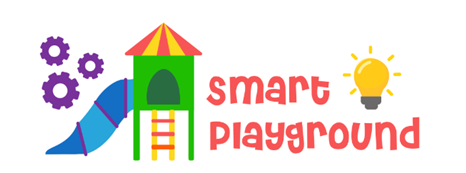 The Smart Playground: Computational Thinking Through Robotics in Early Childhood (Collaborative Research)
The Smart Playground: Computational Thinking Through Robotics in Early Childhood (Collaborative Research)
PIs: Marina Bers, Andres Bustamante, Chris Rogers | CoPI: June Ahn
Grades: PreK, K, Special Education
STEM Disciplines: Technology (Computer Science)
Project Description: The Smart Playground is a research-practice partnership that aims to spark early engagement in computational thinking (CT) among Pre-K, kindergarten, and special education students in Santa Ana, CA, by transforming their school playgrounds into interactive, programmable learning spaces. Our project centers the strengths and lived experiences of our community partners by co-designing with teachers from the Santa Ana Unified School District (SAUSD) and families from the Santa Ana Early Learning Initiative (SAELI). Through this collaborative partnership, we are co-creating an outdoor educational robotics system whose design is directly informed by our community partners' insights, cultural knowledge, and practices. Children will program the Smart Playground by interacting with its controls, lights, and sensors, engaging in collaborative play that builds CT skills like sequencing, modularity, debugging, and control structures. By expanding CT beyond classrooms, the Smart Playground aims to support the development of key CT skills in an active and playful environment. This project offers new insights into how everyday play spaces can become powerful learning tools, particularly in low-resource settings.

What theoretical framework(s) are you using to guide your work?
We use a Design-based Research (DBR) approach that integrates theory, iterative co-design, and real-world implementation. Our work is guided by culturally sustaining design, funds of knowledge, and the seven powerful ideas of CT, drawing from developmental science and CT education.
What kinds of partners did you involve to support your work in PreK-3 learning environments?
We work in close collaboration with the Santa Ana Unified School District (SAUSD) and the Santa Ana Early Learning Initiative (SAELI), which brings deep knowledge of local families and school communities. Our multi-institutional team includes experts in early STEM education, educational robotics, and participatory design from UC Irvine, Tufts University, and Boston College.
What are the unique challenges related to your work in this age range and what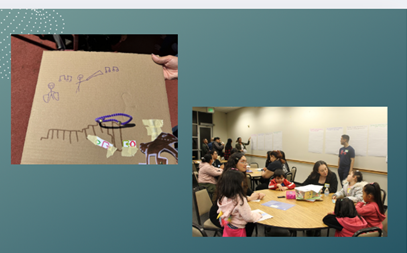 strategies has your project identified for addressing them?
strategies has your project identified for addressing them?
One challenge is developing CT learning experiences that are both age-appropriate and culturally meaningful. We address this by involving children and teachers directly in co-design, grounding the technology in familiar play patterns and values. We also ensure that all components are unplugged and robust enough for outdoor, everyday use.
What is something you think is important for the broader community (other STEM education researchers, policymakers, industry representatives, and/or the public) to know about early STEM learning?
Early childhood is not too early for computer science—when introduced through play and cultural relevance, even young children can engage deeply in computational thinking. Equitable, joyful access to STEM begins with play.
Products:
- Seccia, I. T., Cervera, K., Romano, D., Hays, V. V., Blake-West, J., Bers, M., ... & Ahn, J. (2025). From Accommodation to Inclusive Play: A Culturally Sustaining Design Approach to Play and Learning. In Proceedings of the 19th International Conference of the Learning Sciences-ICLS 2025, pp. 3118-3120. International Society of the Learning Sciences.
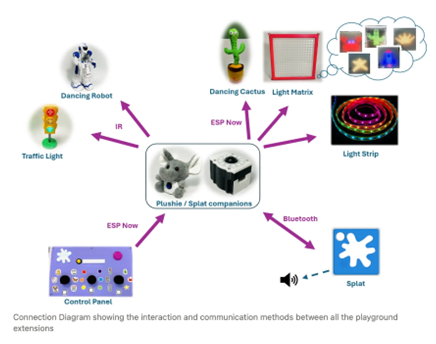
 Young Mathematicians: Expanding an Innovative and Promising Model Across Learning Environments to Promote Preschoolers' Mathematics Knowledge
Young Mathematicians: Expanding an Innovative and Promising Model Across Learning Environments to Promote Preschoolers' Mathematics Knowledge
PI: Jessica Young
Grades: PreK
STEM Disciplines: Mathematics
Project Description: A strong start in early mathematics is a key predictor of long-term academic success—and it begins well before children enter kindergarten. But to build a firm foundation of mathematics skills and knowledge, children need to have meaningful opportunities to engage with early math in all the spaces and places that they live and learn. To meet this need, this design and development project expanded, tested, and refined the Young Mathematicians (YM) program to create a playful approach for skillfully integrating mathematics into home and school settings. Bringing together educators, families, early learning scientists, and mathematics curriculum experts, this project collaboratively designed engaging hands-on early math experiences for children ages 3–7.
YM has three components: games for preschool classrooms that build critical mathematics skills in developmentally appropriate ways; a family math component that fosters math play and stronger connections between school and home; and a professional learning program that provides teachers with early math content knowledge, tools for family engagement, and strategies for fostering positive math mindsets among young children and their caregivers.
This work occurred in two phases: 1) expansion and refinement of program components and 2) a randomized control trial (RCT) to determine the impact of YM on child, family, and teacher outcomes. Findings revealed that YM improved teacher attitudes toward math and increased family involvement in early math learning. While student outcomes were affected by post-pandemic disruptions and teacher turnover, YM students outperformed peers in data literacy and closed gaps in spatial reasoning.
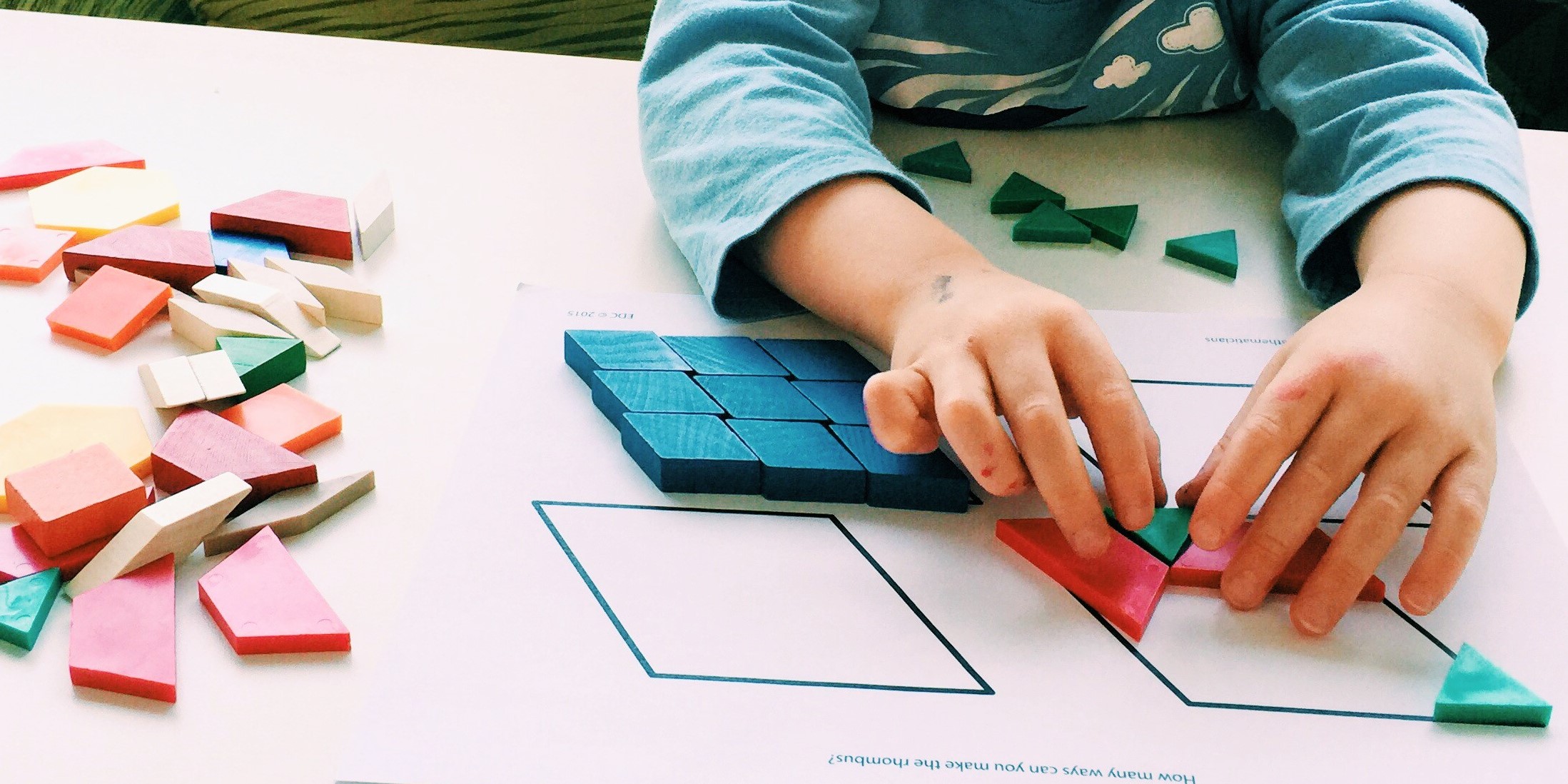 What theoretical framework(s) are you using to guide your work?
What theoretical framework(s) are you using to guide your work?
The Young Mathematicians (YM) project is grounded in sociocultural and constructivist theories of learning, emphasizing the role of play, language, and social interaction in early mathematics development. Our work draws on research in early learning progressions, developmentally appropriate practice, and funds of knowledge frameworks, recognizing that children bring rich experiences from home that can and should be integrated into meaningful math learning.
The project focuses on sparking children’s curiosity and love for mathematics by developing and studying play-based approaches that address critical early mathematics concepts—counting, cardinality, subitizing, patterning, geometry, spatial reasoning, and data collection/analysis—through interactive games, storytelling, and family engagement. YM is designed to be playful and adaptable, allowing for differentiation and deeper learning among all preschoolers, including children from different socio-economic, language, and cultural backgrounds.
At the core of the project is the development and refinement of over 58 freely available early mathematics games with teacher and family instructional supports in the form of videos and direction sheets—along with published game kits—designed to strengthen foundational math concepts through engaging, hands-on learning. These games and instructional resources—hosted at www.ym.edc.org—are available in English, Spanish, and Portuguese. With additional funding support from the Heising-Simons Foundation (#2024-5011), we are adding to this video trove and have so far created an additional 40 instructional videos and game direction sheets in Haitian Creole, broadening participation for multilingual communities.
Initial Project Findings: The YM materials are both instructional tools and professional learning resources that have been designed for use by early childhood teachers and families. In addition, the materials have the advantage of being easy to use in many different settings and contexts, from small group instruction to whole group instruction, from center time to transitions, and from classrooms to homes to libraries.
Using both qualitative and quantitative research methodologies and integrating data from multiple sources and stakeholders, the project successfully supported adult-child interaction and engagement in mathematics by explicitly promoting school-home connections in mathematics for emergent multilingual learners, addressing educators’ and families’ attitudes toward mathematics, promoting children’s mathematical knowledge, and narrowing opportunity gaps.
Teachers reported using YM games for their own learning, to introduce or reinforce math concepts in the classroom, and to extend learning to families through take-home materials and links. Teachers in the YM intervention engaged in more family math practices than teachers in the business-as-usual condition and felt more positive toward early math and family math.
Implementation of the intervention encountered several challenges, however, especially among early childhood teachers navigating the post-pandemic classroom. Many teachers reported lower self-efficacy in their mathematics teaching and felt that external factors—such as frequent student absences, increased teacher absences, and high teacher turnover—significantly disrupted their instruction and limited students’ opportunities to learn. Notably, our analysis showed that students in classrooms where there was turnover of the original teacher were predicted to score significantly LOWER on an early math assessment (Research-based Early Math Assessment-Brief; Marsico Institute, University of Denver) compared to students in a classroom that did not experience teacher turnover.
Through broad dissemination efforts and new partnerships, however, this work will continue to positively impact STEM education pathways by ensuring that all children, regardless of background, receive a strong mathematical foundation. Rooted in the belief that early math learning is a shared responsibility, the project has successfully designed playful instructional materials for broad use, ensuring relevance and feasibility of implementation across settings and contexts.
Products
Website: Young Mathematicians Online Platform
Videos:
- Young Mathematicians YouTube Channel
- Young Mathematicians: Transforming PreK Learning Environments, 2021 NSF STEM for All Video Showcase
Young Mathematicians Games: See All
- Young, J. M., Reed, K. E., Clements, L., Schifter, D., Spencer, D. B., Goldenberg, E. P., Thompson, S., & Coletti, L. (2023). Pattern and Sorting Games: Kit Guide. New Path Learning.
- Reed, K. E., Young, J. M., Clements, L., Schifter, D., Spencer, D. B., Goldenberg, E. P., Thompson, S., & Coletti, L. (2023). Dot Card Games: Kit Guide. New Path Learning.
- Young, J. M., Reed, K. E., Clements, L., Schifter, D., Spencer, D. B., Goldenberg, E. P., Thompson, S., & Coletti, L. (2023). Games with Cards and Dice: Kit Guide. New Path Learning.
- Reed, K. E., Young, J. M., Clements, L., Schifter, D., Spencer, D. B., Goldenberg, E. P., Thompson, S., & Coletti, L. (2023). Games with Fingers and Counters. New Path Learning.
- Young, J. M., Reed, K. E., Clements, L., Schifter, D., Spencer, D. B., Goldenberg, E. P., Thompson, S., & Coletti, L. (2023). Shape Cards: Kit Guide. New Path Learning.
- Reed, K. E., Young, J. M., Clements, L., Schifter, D., Spencer, D. B., Goldenberg, E. P., Thompson, S., & Coletti, L. (2023). Movement Games: Kit Guide. New Path Learning.
- Reed, K. E., Young, J. M., Clements, L., Schifter, D., Spencer, D. B., Goldenberg, E. P., Thompson, S., & Coletti, L. (2023). Shape Games and Puzzles: Kit Guide. New Path Learning.
Book Chapter:
- Young, J. M. & Reed, K. E. (2024). It all adds up: Connecting home, school, and communities through family math. In H. Senol & K.M. Stavropoulos (Eds.), Recent Perspectives on Preschool Education and Care. IntechOpen. https://doi.org/10.5772/intechopen.112714
Suggested Reading:
- Young, J. M., Reed, K. E., Rosenberg, H., & Kook, J. (2023). Adding family math to the equation: Promoting Head Start preschoolers’ mathematics learning at home and school. Early Childhood Research Quarterly, 63, 43–58. https://doi.org/10.1016/j.ecresq.2022.11.002
- Reed, K. E., & Young, J. M. (2022, July/August). Young Mathematicians: A successful model of a family math community. Connected Science Learning, 4(4). https://www.nsta.org/connected-science-learning/connected-science-learning-july-august-2022/young-mathematicians
Related Resources
CADRE Reports and Briefs
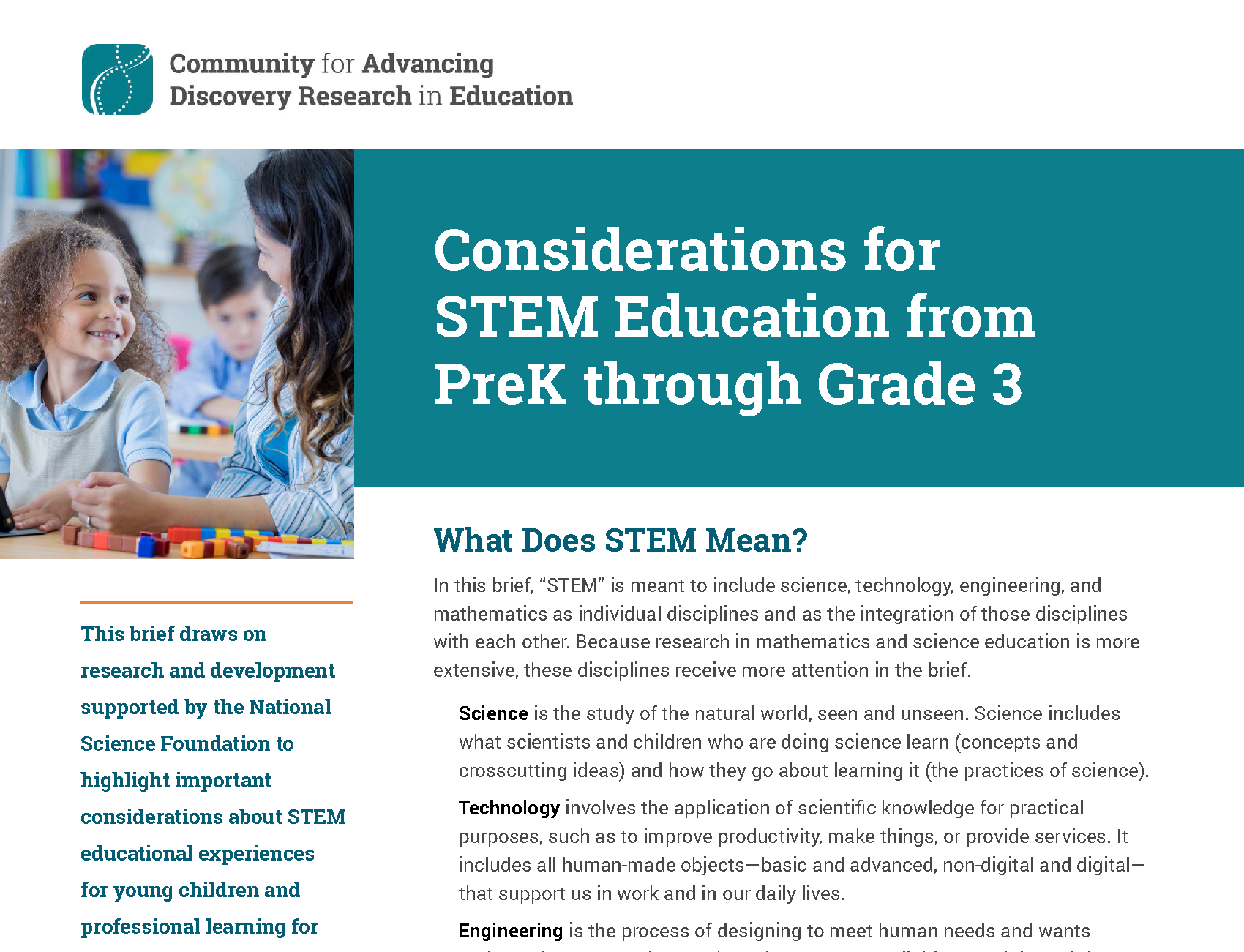 Considerations for STEM Education from PreK Through Grade 3
Considerations for STEM Education from PreK Through Grade 3
This brief draws on research and development supported by the National Science Foundation to highlight important considerations about STEM educational experiences for young children and professional learning for educators who provide those experiences. See References, Authors and Contributors, and Practitioner-Oriented Resources.
Nurturing STEM Skills in Young Learners
This brief was produced in connection with the STEM Smart event held in Washington, D.C. in December, 2013. It highlights challenges, key research, and promising program in critical areas of the early education landscape.
Learn more about the STEM Smart workshop on early childhood.
National Academies of Sciences, Engineering, and Medicine (NASEM) Reports
- A New Vision for High Quality Pre-K Curriculum (2024)
- Rise and Thrive with Science: Teaching PK-5 Science and Engineering (2023)
- Addressing the Impact of COVID-19 on the Early Care and Education Sector (2022)
- Science and Engineering in Preschool Through Elementary Grades: The Brilliance of Children and the Strengths of Educators (2022)
DRK-12 Publications
- Aligning Test Scoring Procedures with Test Uses: A Balancing Act
Test scoring procedures should align with the intended uses and interpretations of test results. In this paper, we examine three test scoring procedures for an operational assessment of early numeracy, the Early Grade Mathematics Assessment (EGMA). - Analysis of the e-TEN Calibration Data
The present report summarizes the analyses of the calibration data for the electronic Test of Early Numeracy (e-TEN), an adaptive, iPad-based test of early numeracy achievement. - Applying the Curriculum Research Framework in the Design and Development of a Technology-Based Tier 2 Mathematics Intervention
The Precision Mathematics curriculum incorporates (a) technology-based activities that offer individualized opportunities for instruction and practice and (b) hands-on activities that promote small-group instructional interactions. Our production of the first-grade Precision Mathematics intervention was grounded in the CRF, which involves a series of iterative cycles of development, implementation field-testing, analysis, and revision. - Articulating a Transformative Approach for Designing Tasks that Measure Young Learners’ Developing Proficiencies in Integrated Science and Literacy
In this paper, we introduce an approach for designing NGSS-aligned assessments that measure young learners’ science progress while also attending to the scientific language and literacy practices that are integral parts of the NGSS Performance Expectations. - Asset-based Computational Thinking in Early Childhood Classrooms: Centering Students’ Expertise in a Community of Learners
The purpose of this qualitative study was to explore how early childhood teachers enacted asset-based pedagogies while implementing CT in their classrooms. - Best of Both Worlds: Developing an Innovative, Integrated, Intelligent, and Interactive System of Technologies Supporting In-Person and Digital Experiences for Early Mathematics
Building on a quarter-century of research, we are developing and evaluating an innovative, integrated, intelligent, and interactive system of technologies based on empirically validated learning trajectories that provide the best personal and digital tools for assessing and supporting children’s mathematics learning. This article reviews the research that guided us, then describes the design principles of the new project, justifying their selection using theory and research, and shares how the design principles helped address challenges in development. - The Centrality of Student-Generated Representation in Investigating Generalizations about the Operations
This article addresses the nature of student-generated representations that support students’ early algebraic reasoning in the realm of generalized arithmetic. - Children’s Integer Understanding and the Effects of Linear Board Games: A Look at Two Measures
The purpose of this study was to identify affordances and limitations of using order and value comparison tasks versus number placement tasks to infer students’ negative integer understanding and growth in understanding. - Children’s Measurement: A Longitudinal Study of Children’s Knowledge and Learning of Length, Area, and VolumeThe sixteenth Journal for Research in Mathematics Education (JRME) monograph is a report on a four-year-long multisite longitudinal study that studied children’s thinking and learning about geometric measurement (i.e., length, area, and volume). In this study, the research team worked with the same group of children at a Northeast site from pre-K to grade 2, and with a different group of students at a Midwest site from grade 2 through grade 5.
- Constructing the ScratchJr Programming Language in the Early Childhood Classroom
This paper seeks to contribute to the growing literature on children and computer programming by focusing on a programming language for children in Kindergarten through second grade. - Culturally Responsive Mathematics Engagement Through a Family-Inspired Mathematizing Routine
This exploratory qualitative study looked at a mathematical routine, focused on family-provided photos and artifacts, that elicited children’s mathematical and general observations and inquiries and engaged families in mathematical communications. - The Development and Validation of a Survey Measuring Opportunity to Learn Spatial Reasoning Skills at Home
The purpose of the current study is to develop a survey instrument to better understand Kindergarten through Grade 2 students’ opportunities to learn spatial reasoning skills at home. This manuscript outlines the interpretation/use argument that guides our validation study and presents evidence collected to evaluate the scoring inferences for using the survey to measure students’ opportunities to learn spatial reasoning skills at home. - Does Early Algebra Matter? The Effectiveness of an Early Algebra Intervention in Grades 3 to 5
A cluster randomized trial design was used to examine the effectiveness of a Grades 3 to 5 early algebra intervention with a diverse student population. - Does Use of a Hypothetical Learning Progression Promote Learning of the Cardinal-Count Concept and Give-n Performance?
The general aim of the research was to conduct a rare test of the efficacy of hypothetical learning progressions (HLPs) and a basic assumption of basing instruction on HLPs, namely teaching each successive level is more efficacious than skipping lower levels and teaching the target level directly. The specific aim was evaluating whether counting-based cardinality concepts unfold in a stepwise manner. - Early Childhood Educators’ Self-Efficacy in Science, Math, and Literacy Instruction and Science Practice in the Classroom
Little is known about how teachers’ self-efficacy for literacy, math and science compare and how domain-specific self-efficacy relates to teachers’ practice in the area of science. Analysis of survey and observation data from 67 Head Start classrooms across eight programs indicated that domain-specific self-efficacy was highest for literacy, significantly lower for science, and lowest for math. - Early Childhood Teachers’ Use of Asset-based Computational Thinking Pedagogy: Centering Students’ Expertise and Life Experiences
The purpose of this paper is to share a subset of findings from a qualitative, ethnographic study that explored the ways in which early childhood teachers (ECT) learned and implemented CT using asset-based pedagogies. The research question addressed is: In what ways do ECT use asset-based pedagogies while implementing CT in their classrooms? - Efficacy of a First-Grade Mathematics Intervention on Measurement and Data Analysis
This study investigated the efficacy of the Precision Mathematics Level 1 (PM-L1) intervention, a Tier 2 print- and technology-based mathematics intervention designed to increase first-grade students’ conceptual understanding and problem-solving skills around the areas of measurement and data analysis. - Families’ Capacity to Engage in Science Inquiry at Home Through Structured Activities
The role that caregivers can play in their child’s science education is often overlooked within science education research. Few studies have focused on the capacity and abilities of caregivers to guide science activities. The purpose of this study was to describe how families utilize science activity packs at home. - Imagining a Future in 4k: How Professional Identity Shapes Notions of Mathematics
This article describes how early childhood teachers engaged in a public preK professional development program. We examine how developing teacher identities mediated engagement with the discourses of developmentally appropriate practice, early mathematics, and funds of knowledge and how they connected present practice to an imagined future. - Impact of Model‐based Science Curriculum and Instruction on Elementary Students' Explanations for the Hydrosphere
This study describes a comprehensive evaluation of a 5‐year, design‐based research project focused on the development, implementation, revision, and testing of an enhanced, model‐centered version of the Full Option Science System (FOSS) Water (2005) unit in third grade classrooms. - The Impact of Teacher Gender on Girls’ Performance on Programming Tasks in Early Elementary School
The goal of this paper is to examine whether having female robotics teachers positively impacts girls’ performance on programming and robotics tasks. - Integrating STEM into Preschool Education: Designing a Professional Development Model in Diverse Settings
In this article, we outline the main components of a professional development model and the iterative design process we undertook to ensure that the professional supports are relevant and effective for teachers and children. Finally, the article presents feedback from educators who participated in the design and implementation of the model, as well as discussion of how our process can inform other teacher educators and those interested in promoting early STEM in diverse preschool settings. - It All Adds Up: Connecting Home and School Through Family Math
In this chapter, we consider the approach of the Young Mathematicians (YM) project at EDC, which for the past ten years, has partnered with families, teachers, and early childhood programs in richly diverse communities with large populations of students of color, linguistically minoritized students, and students living in poverty, to support math learning across home and school environments. - Iterative Cognitive Interview Design to Uncover Children’s Spatial Reasoning
This paper describes the iterative development of protocols for cognitive interviews with kindergarten through second-grade children to understand how their spatial reasoning skill development aligns with intended constructs. - Length Measurement in the Early Years: Teaching and Learning with Learning Trajectories
We previously introduced, refined, and validated a developmental progression – the cognitive core of a learning trajectory–for length measurement in the early years. A complete learning trajectory includes instructional activities and pedagogical strategies, correlated with each level of the developmental progression. This study evaluated a portion of our learning trajectory, focusing on the instructional component. - A Pleasure to Measure! Tasks for Teaching Measurement in the Elementary Grades
This book presents lively activities that dovetail with standards and research-based stages of development to support students’ steady growth of understanding of measurement. With individual chapters for kindergarten through grade 5, A Pleasure to Measure includes 65 classroom-ready activities on measurement, along with a summary of learning goals, connections to children’s literature, and ideas for extending beyond the activities. - Pumping Up Curiosity: How Child-Led Play Fuels Early Science Learning
This article emphasizes the critical role of play in early childhood science education, arguing that natural, child-led play fosters important opportunities for children to explore scientific ideas and practices. - Robotics in the Early Childhood Classroom: Learning Outcomes from an 8-Week Robotics Curriculum in Pre-kindergarten Through Second Grade
This study looks at N=60 children in pre-kindergarten through second grade who completed an 8-week robotics curriculum in their classrooms using the KIWI robotics kit combined with a tangible programming language. - The Role of Balance Scales in Supporting Productive Thinking about Equations Among Diverse Learners
This research focuses on ways in which balance scales mediate students’ relational understandings of the equal sign. - The Role of Whole-Class Conversations in Supporting Early Elementary Students’ Engineering Design Sense-Making
We consider how intentionally planned and facilitated whole-class conversations can “make space” for students’ sense-making about engineering problems and solutions and position them with epistemic authority to contribute to collective thinking. We conducted a case study on a first-grade engineering lesson that included whole-class Idea Generation and Design Synthesis Talks. - ScratchJr: A Coding Language for Kindergarten
This study presents an assessment tool to track Kindergarten through second grade students’ learning after engaging in a programming curriculum. - Shining Light on Preschool Science Investigations: Exploring Shadows and Strengthening Visual Spatial Skills
In this article, we describe a set of light and shadows activities. Through these playful hands-on and digital app investigations, children explore how shadows are made and change. - STEM Starts Early: Grounding Science, Technology, Engineering, and Math Education in Early Childhood
This report summarizes the latest research findings on the importance and impact of early STEM across the child's ecological systems, as well as the critical importance of framing communications about early STEM in an effective way. It also articulates six recommendations for practice, policy, and research that will promote dramatic improvement in early STEM education for all young children. - Systematic Review of Learning Trajectories in Early Mathematics
We review research over the last five years to describe what is known and what still needs to be learned about methods of development, refinement, and validation of the goals, developmental progressions, and instruction of learning trajectories in early mathematics and possible advantages and disadvantages in the educational application of learning trajectories. - Toward a Theoretical Structure to Characterize Early Probabilistic Thinking
The purpose of this report is to sketch a tentative theoretical structure with the potential to anchor curricular decisions and inform further research on early probability learning. - Quantification in Empirical Activity
We argue that, from elementary school, children can experience quantification, or identifying, developing, and working with variables, as consequential and can take up differences in representation and scale in empirical investigations as opportunities for sense-making and conceptual progress. - They Learn When They Learn Coding: Investigating Cognitive Domains and Computer Programming Knowledge in Young Children
This study investigated N=57 Kindergarten through second grade children’s performance on a programming assessment after engaging in a 6-week curricular intervention. - “You are Never too Little to Understand Your Culture”: Strengthening Early Childhood Teachers through the Diné Institute for Navajo Nation Educators
In this article, we describe one effort to strengthen early childhood teaching in schools on the Navajo Nation. We center the work of two teachers (the second and third authors of this manuscript), and we situate their work within a program attempting to support teachers in the development of academically rigorous, culturally responsive curriculum across the Navajo Nation
